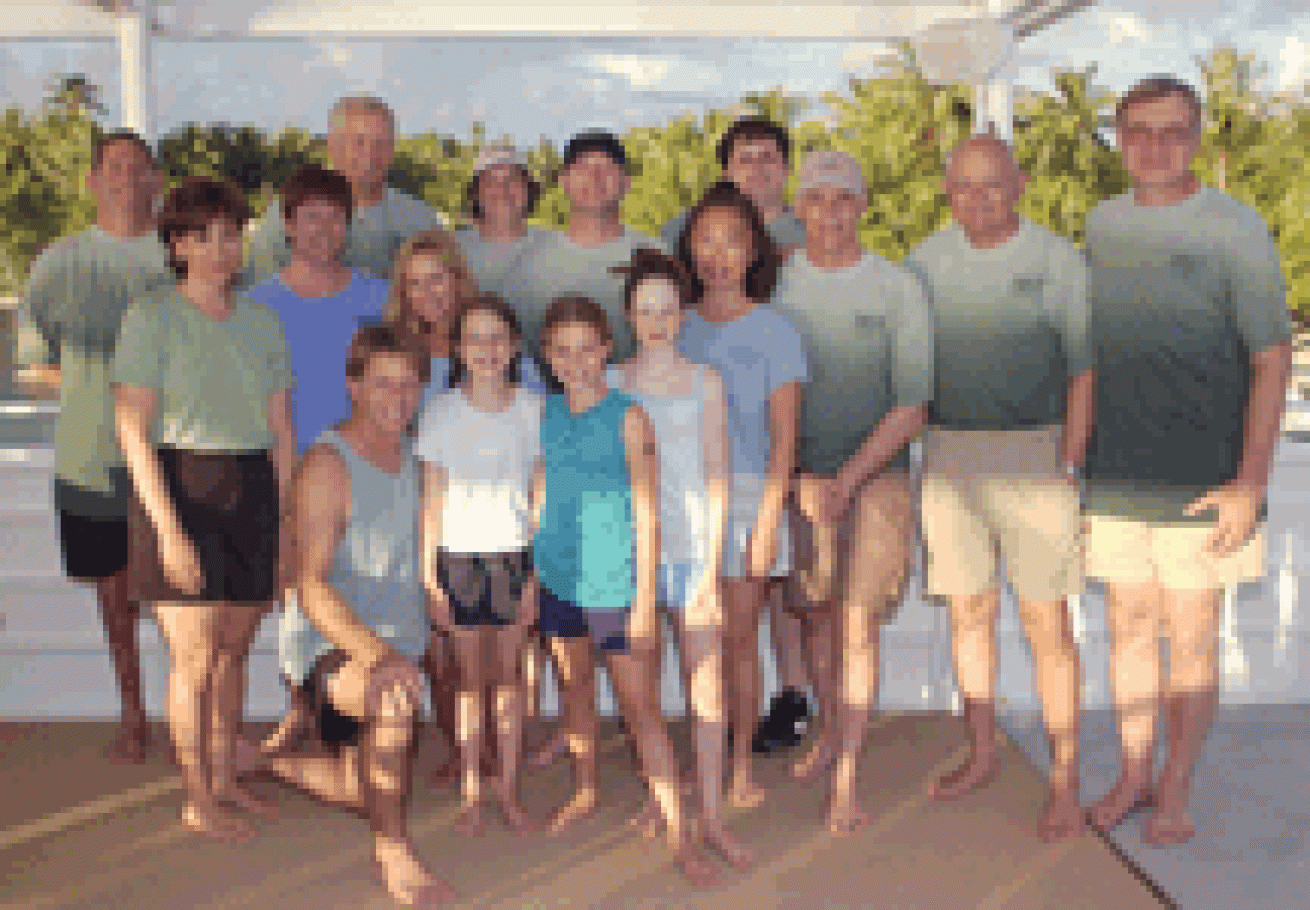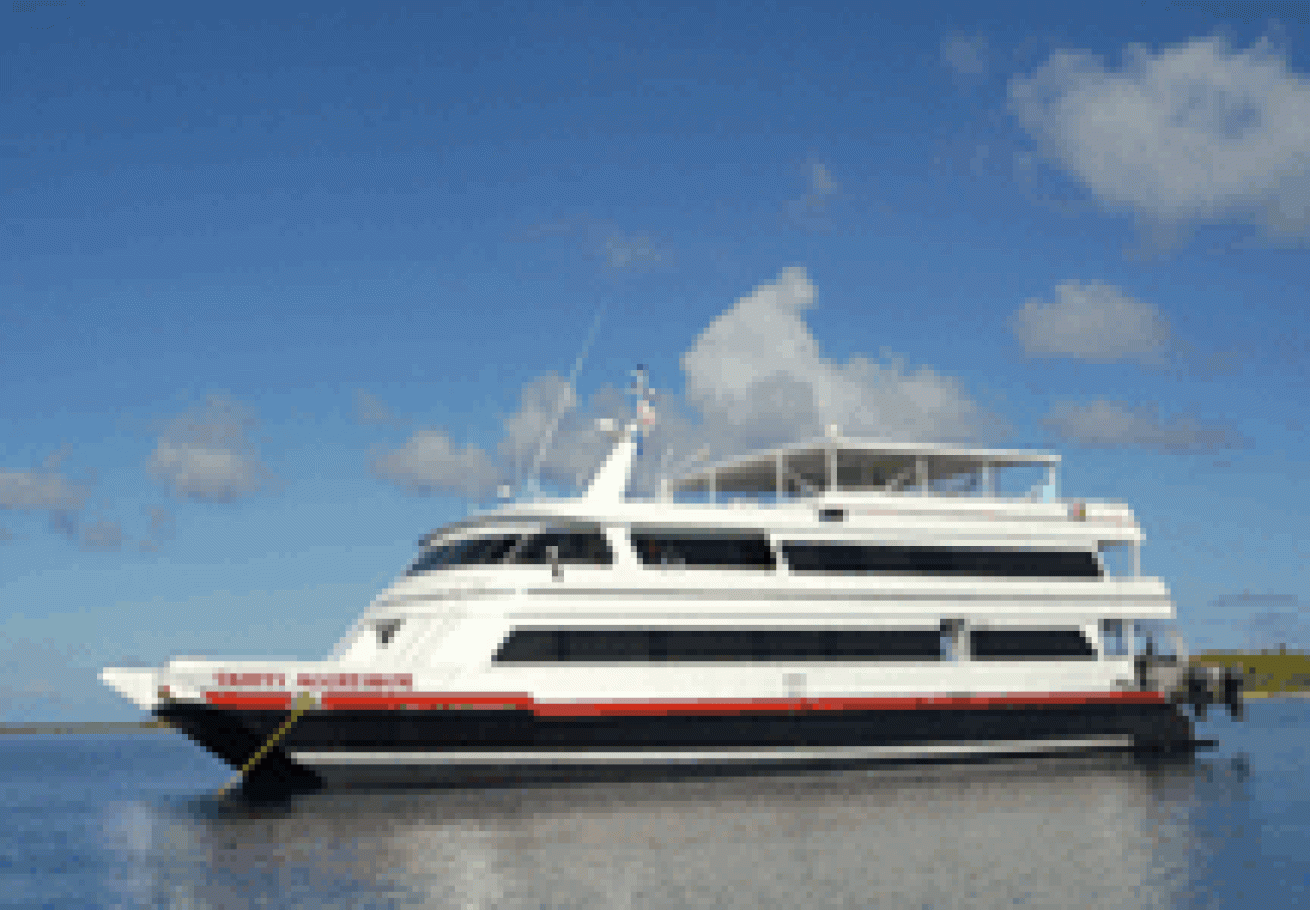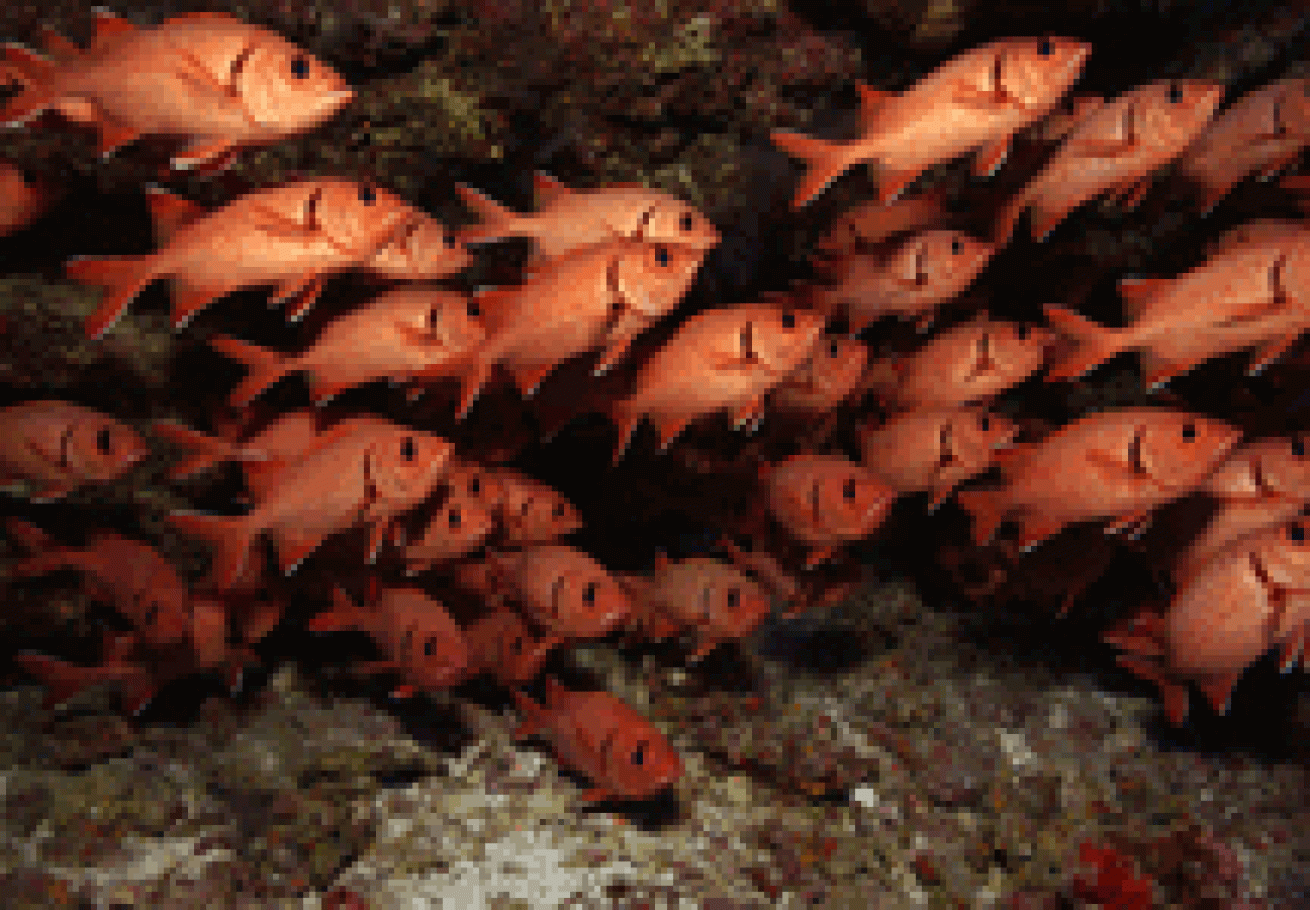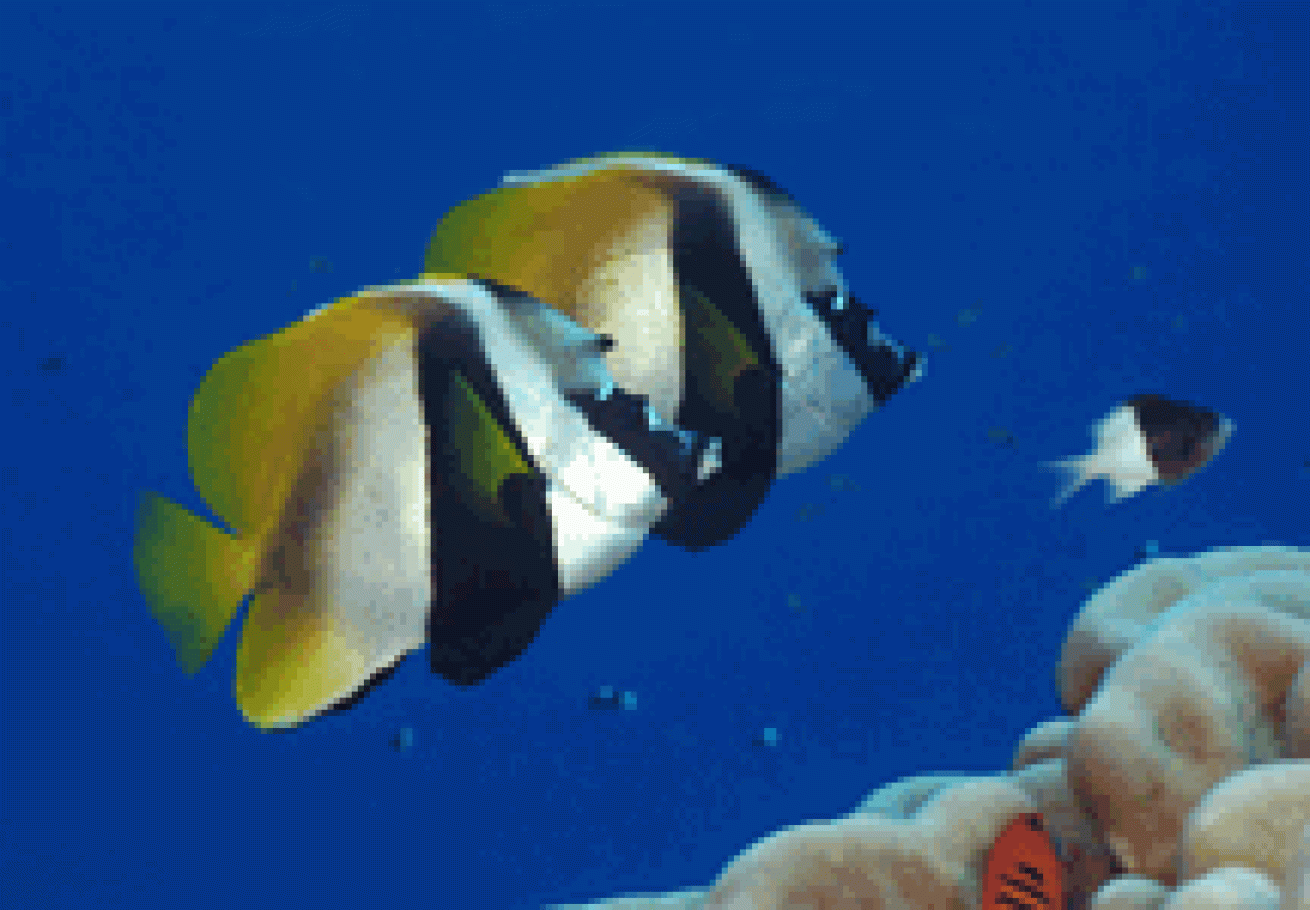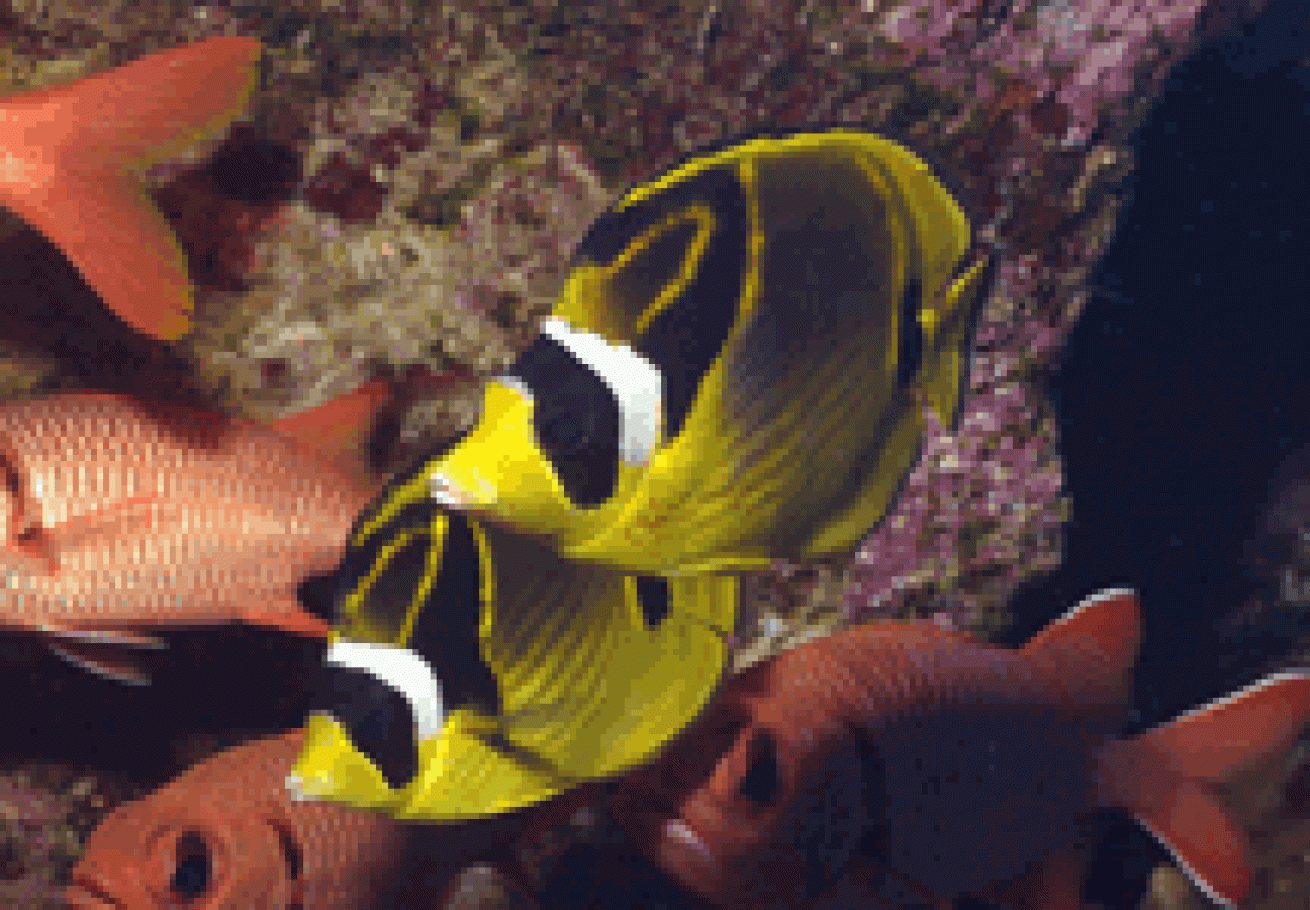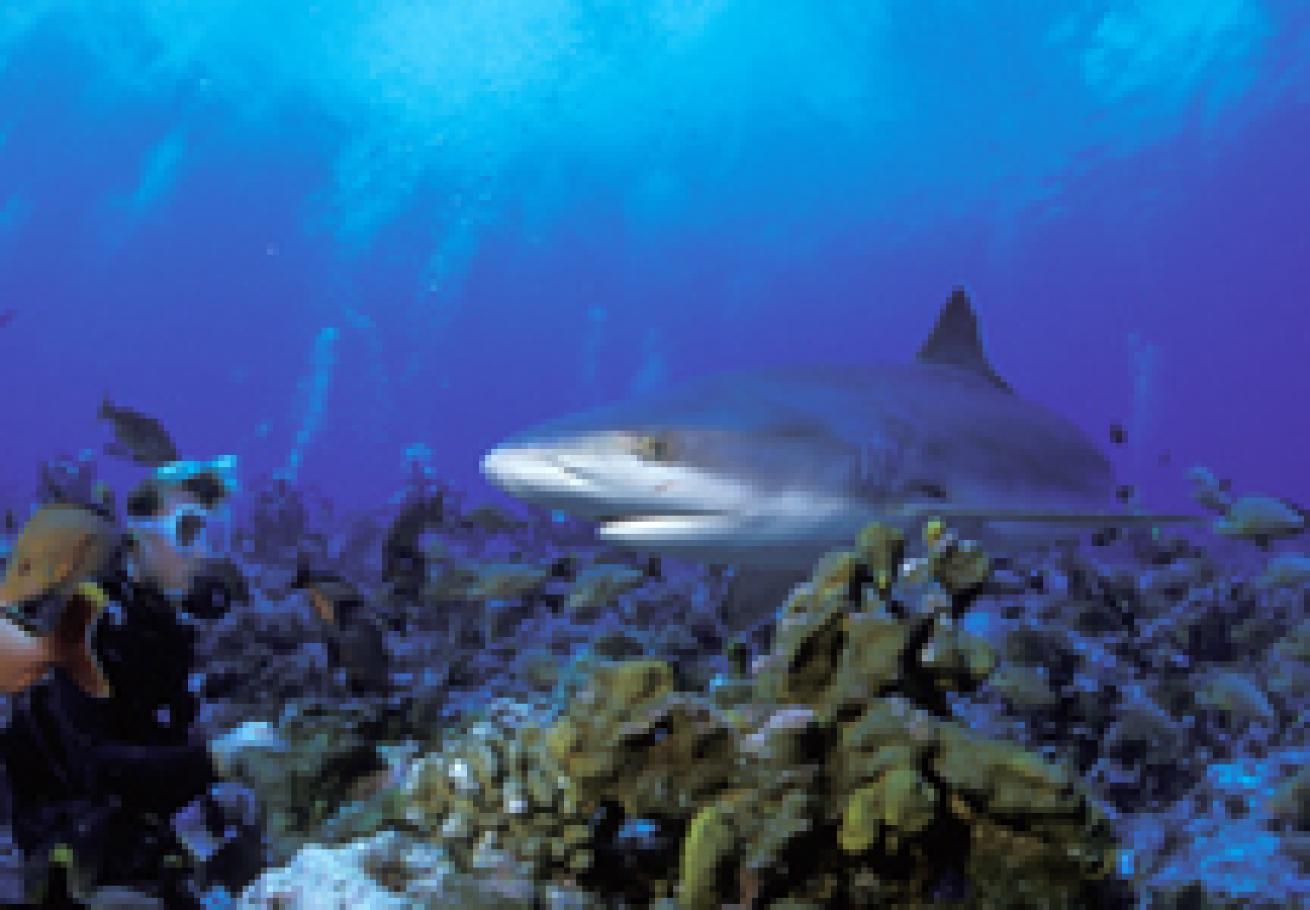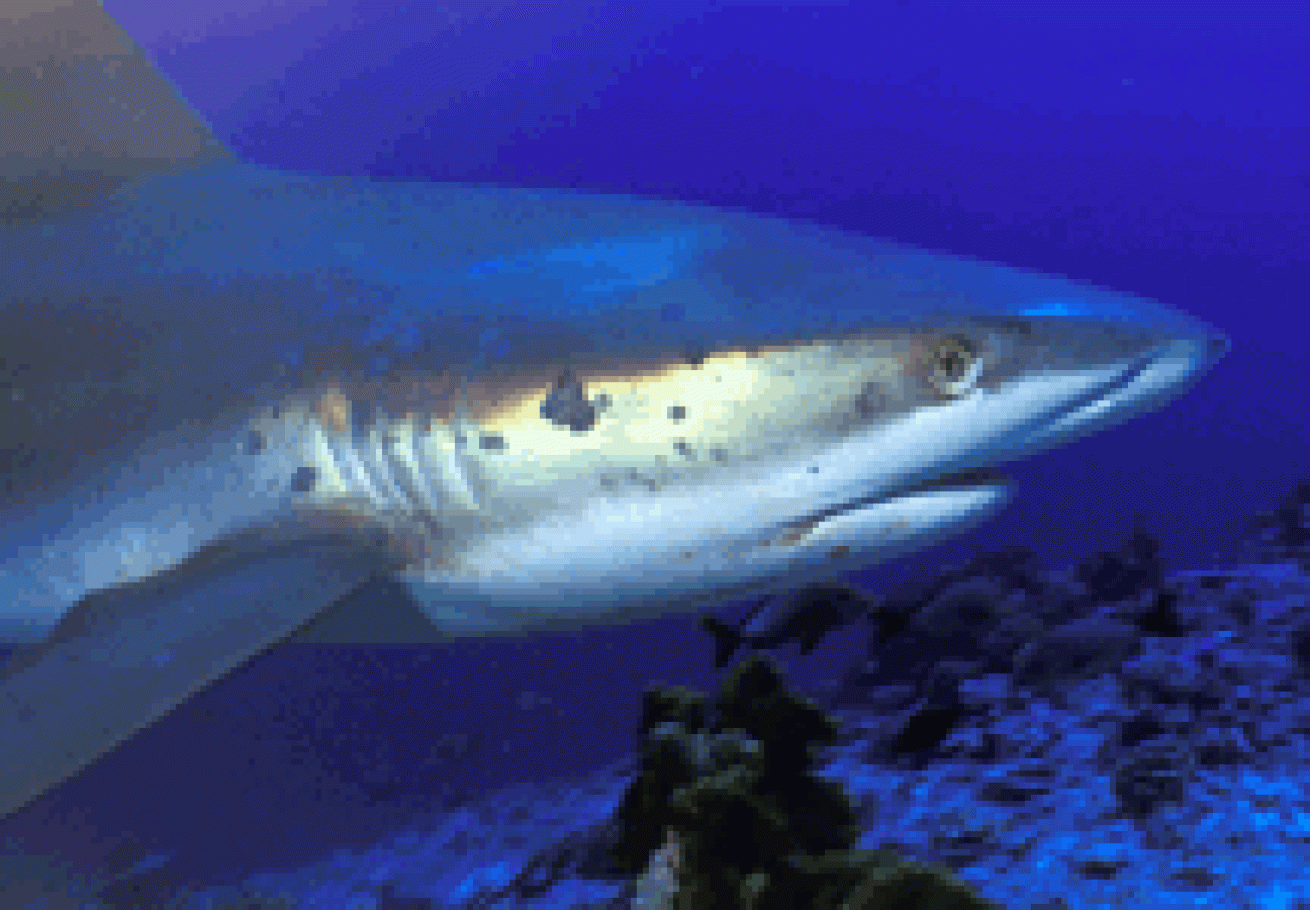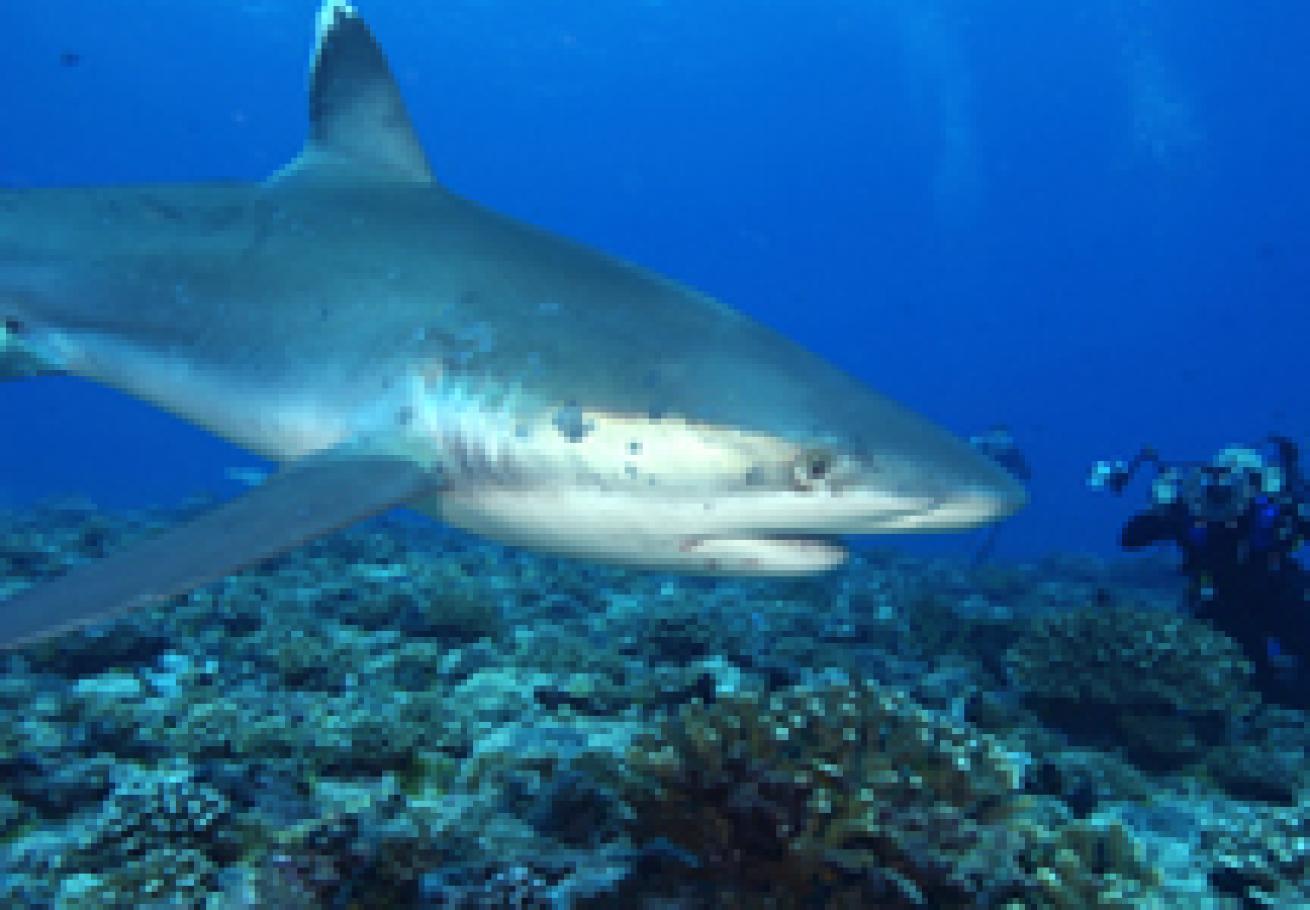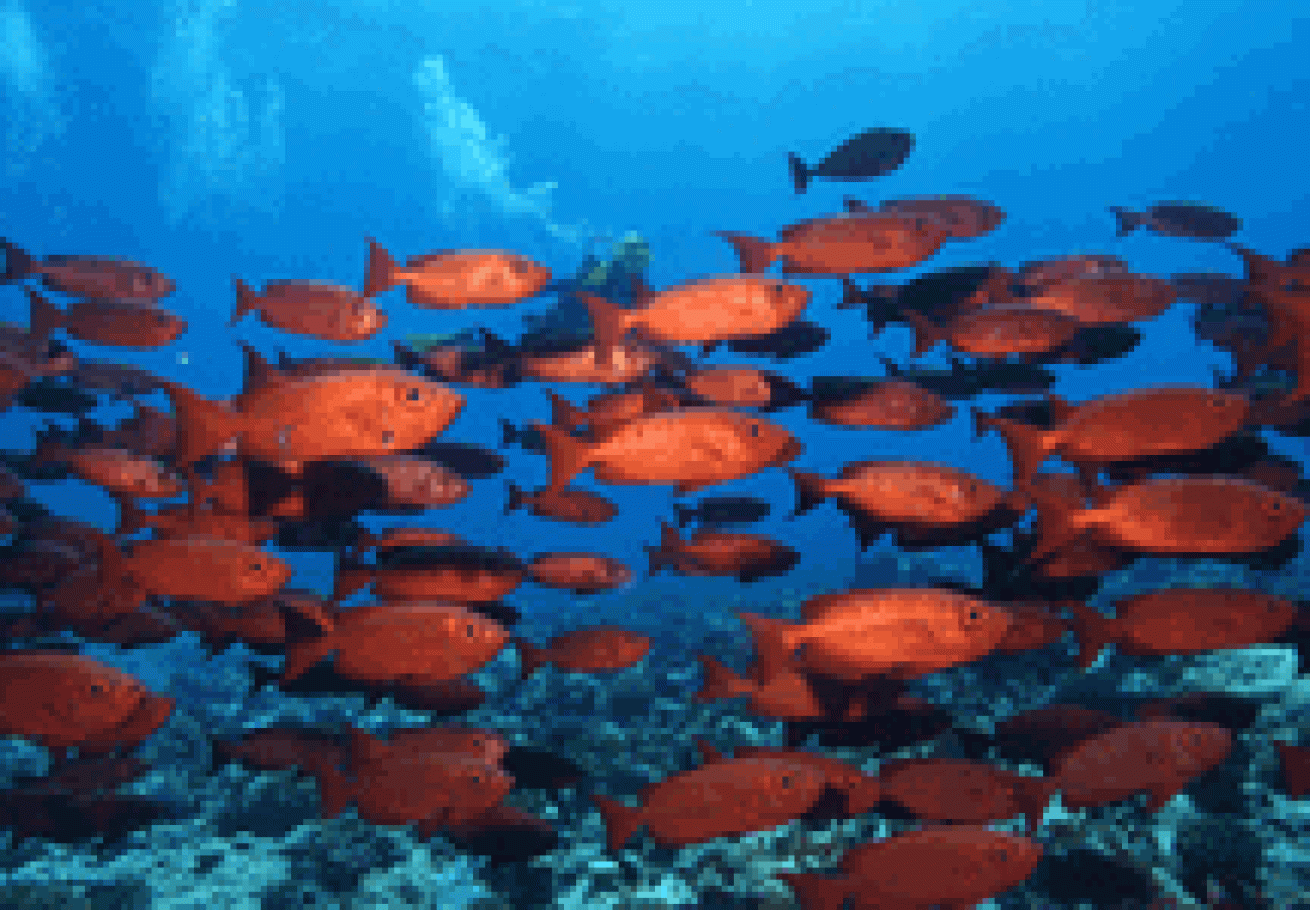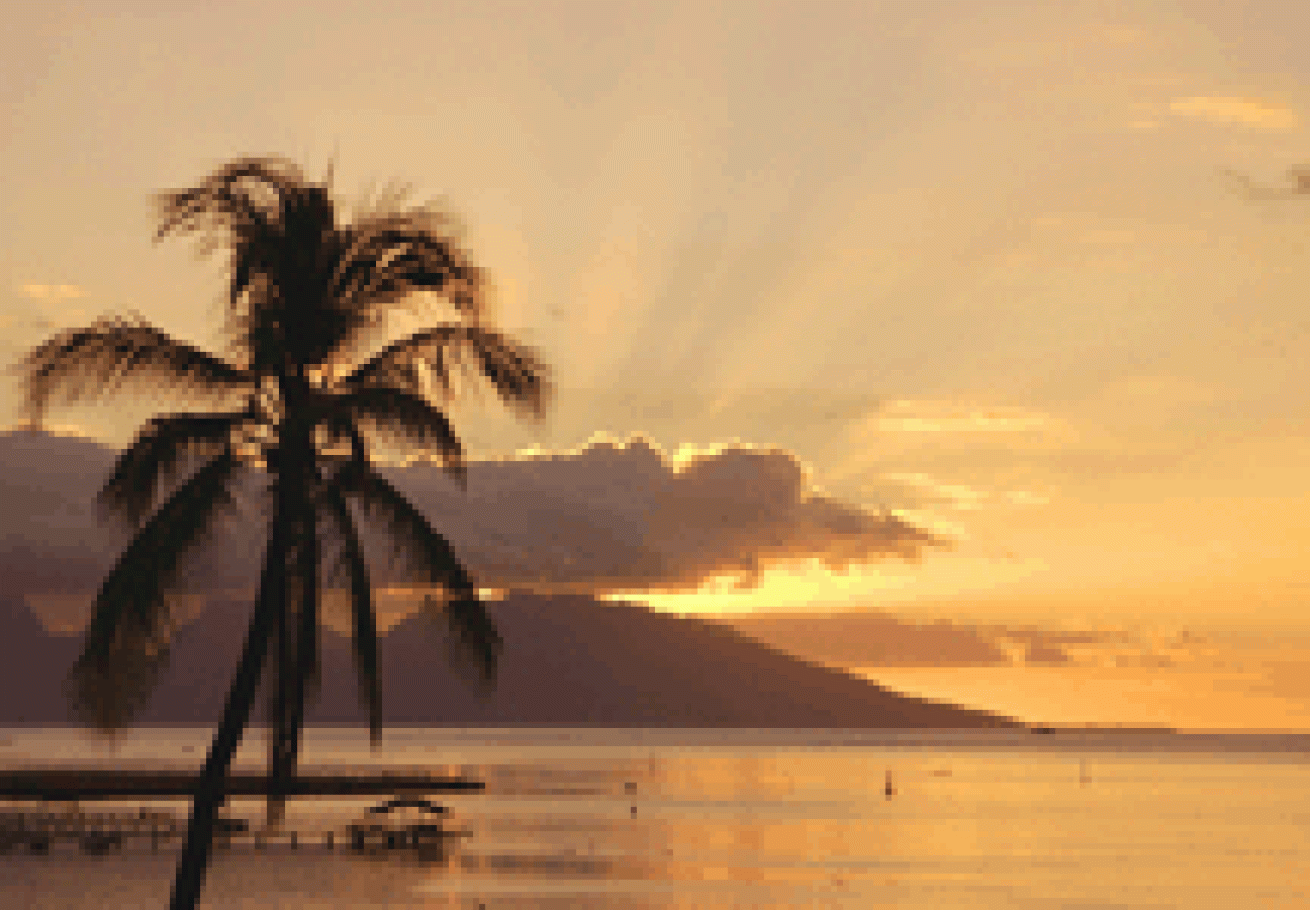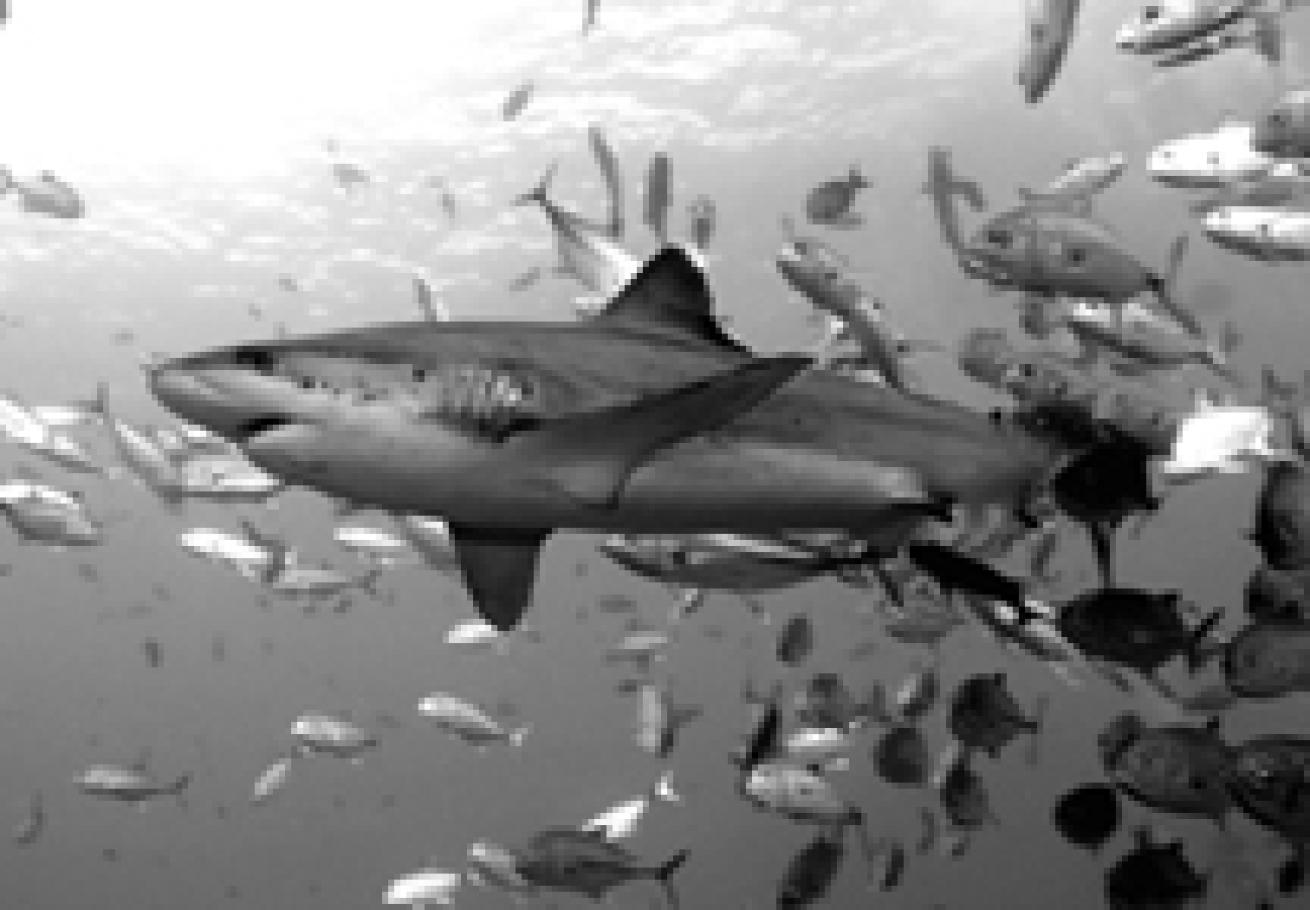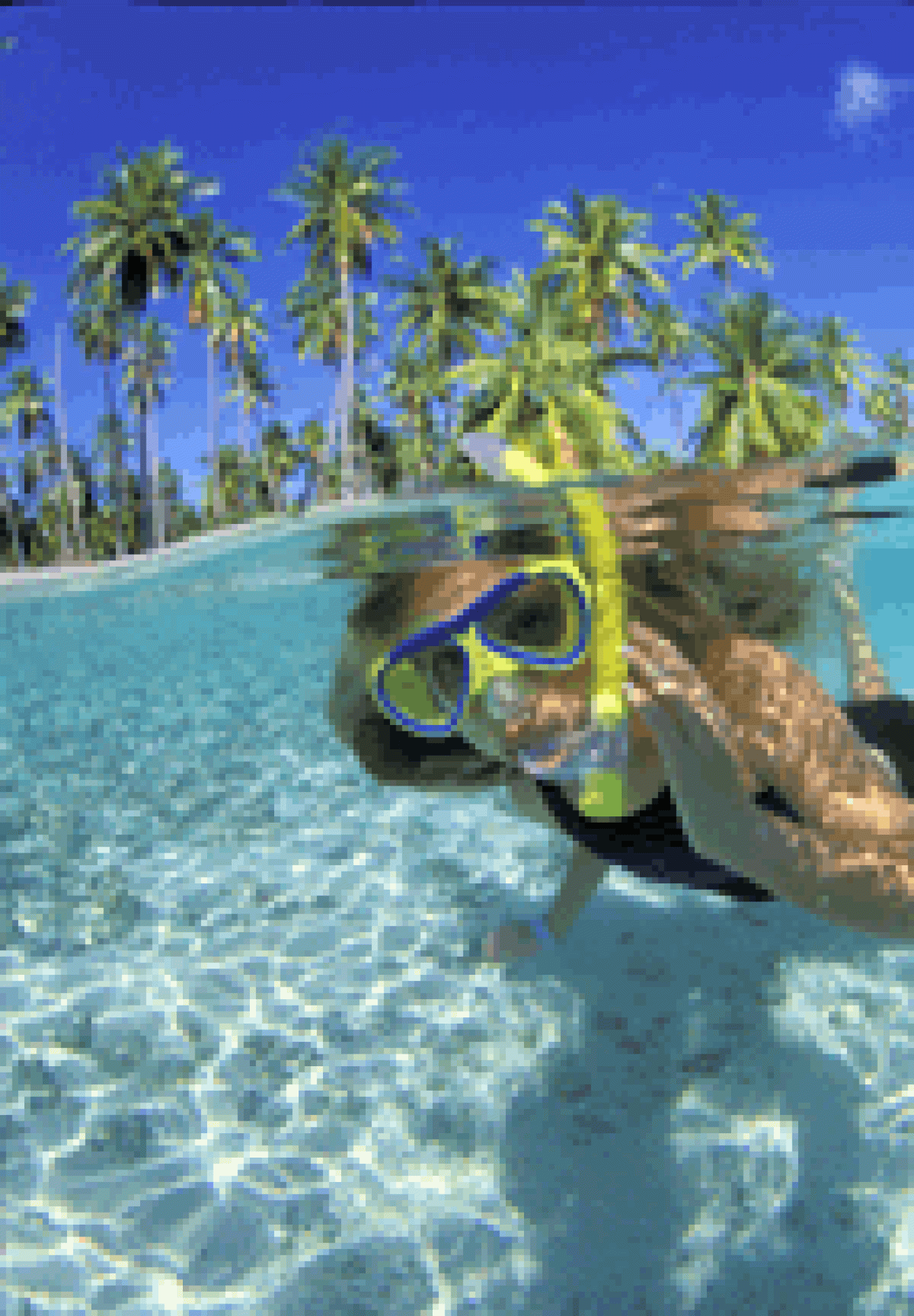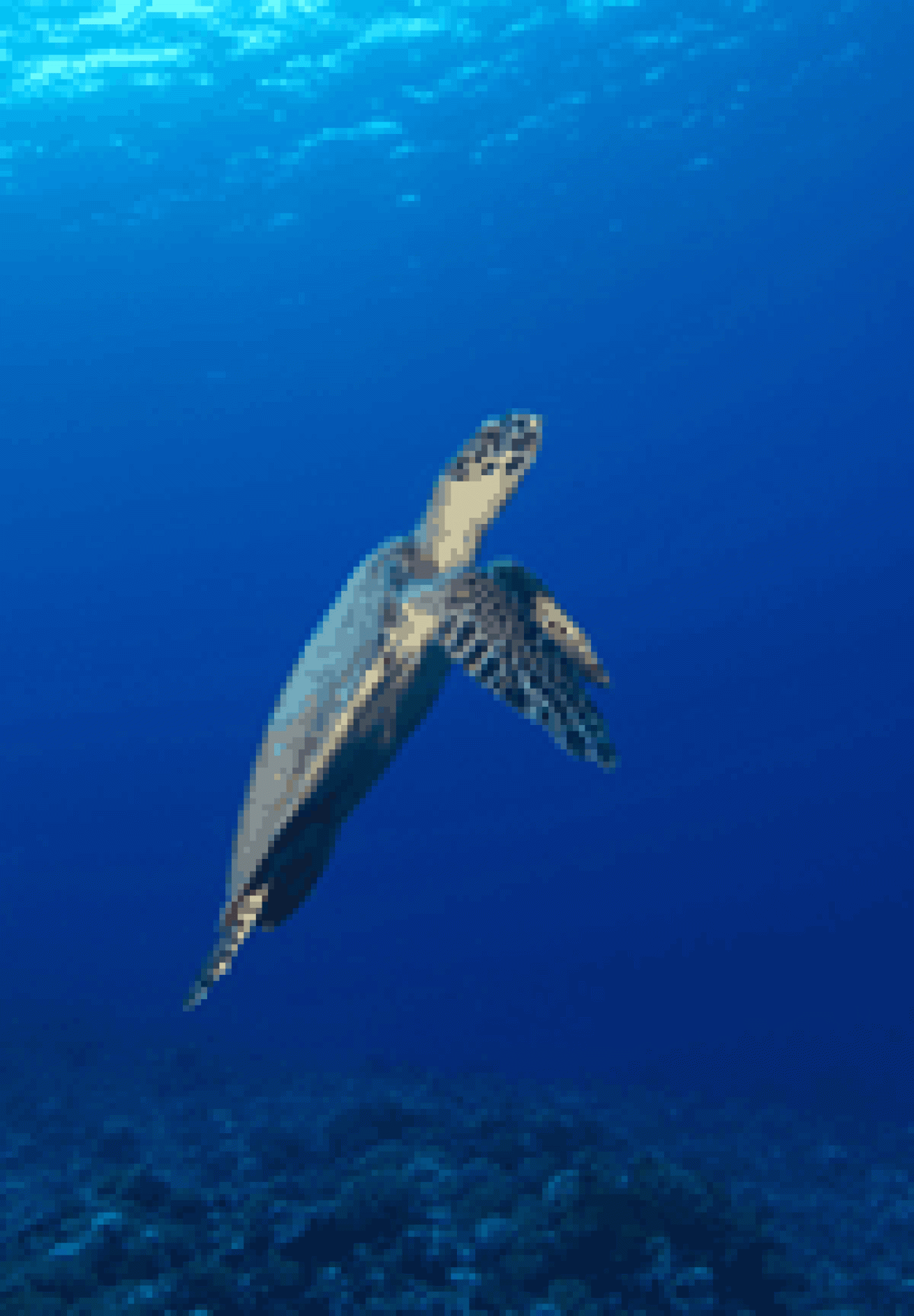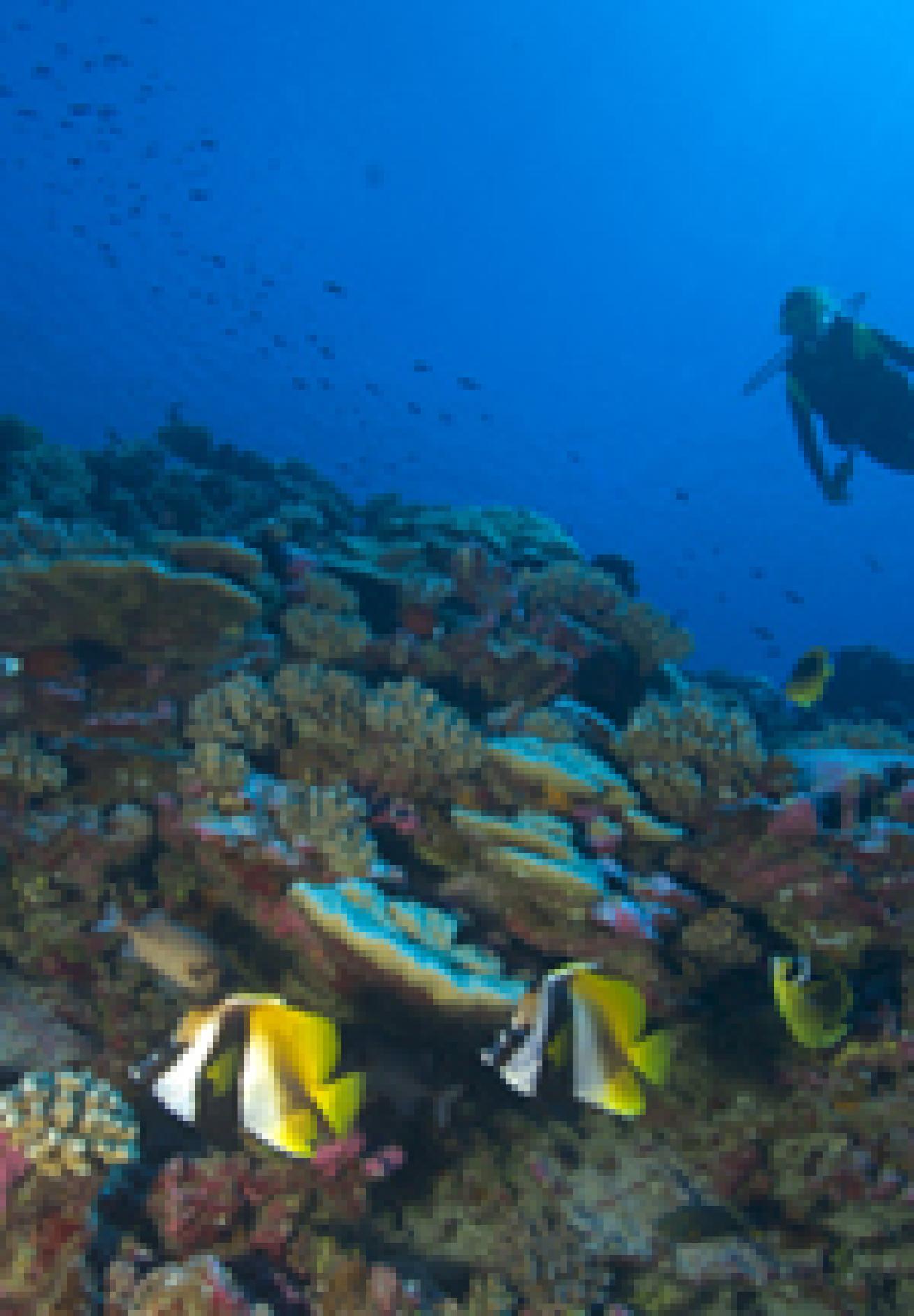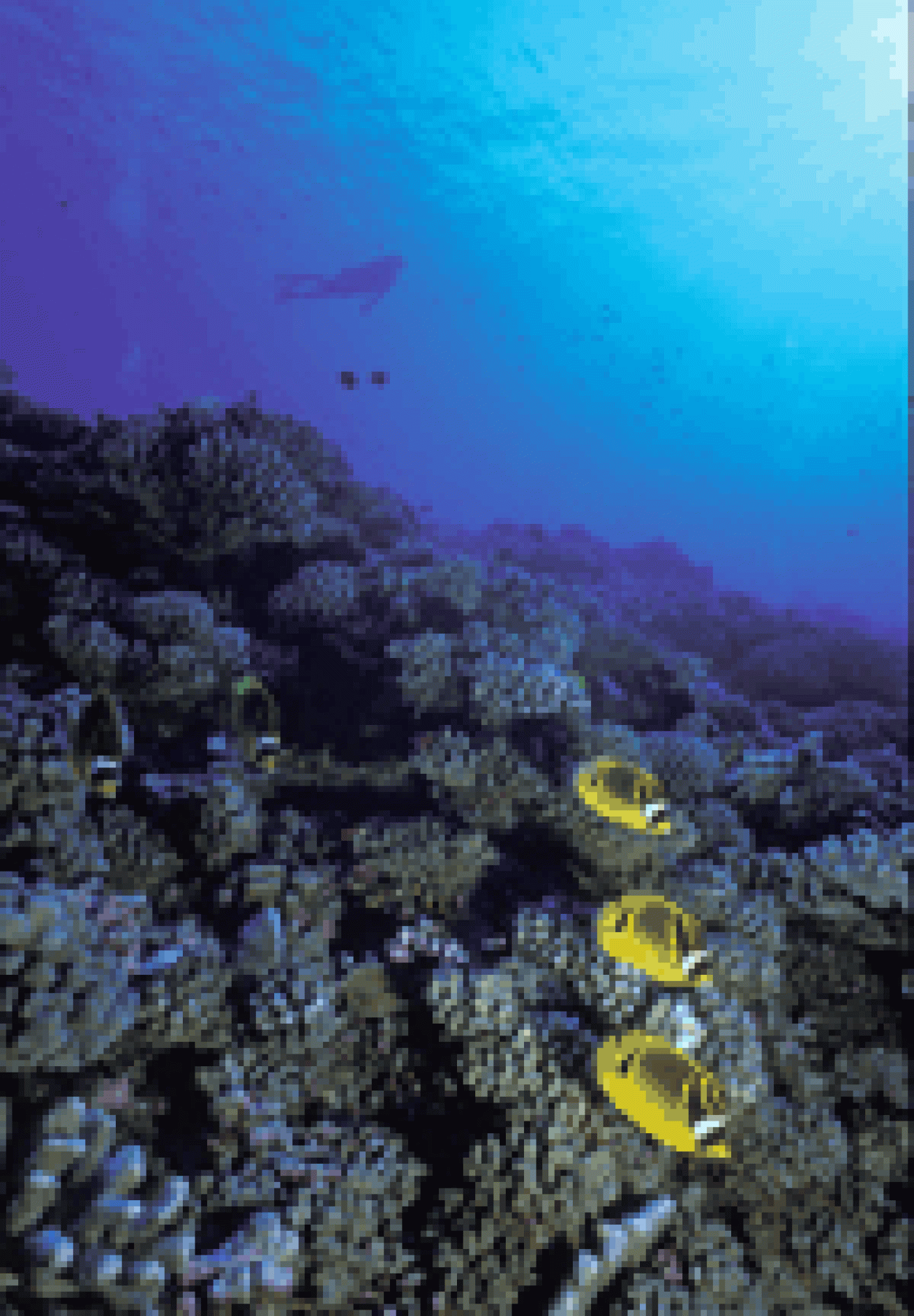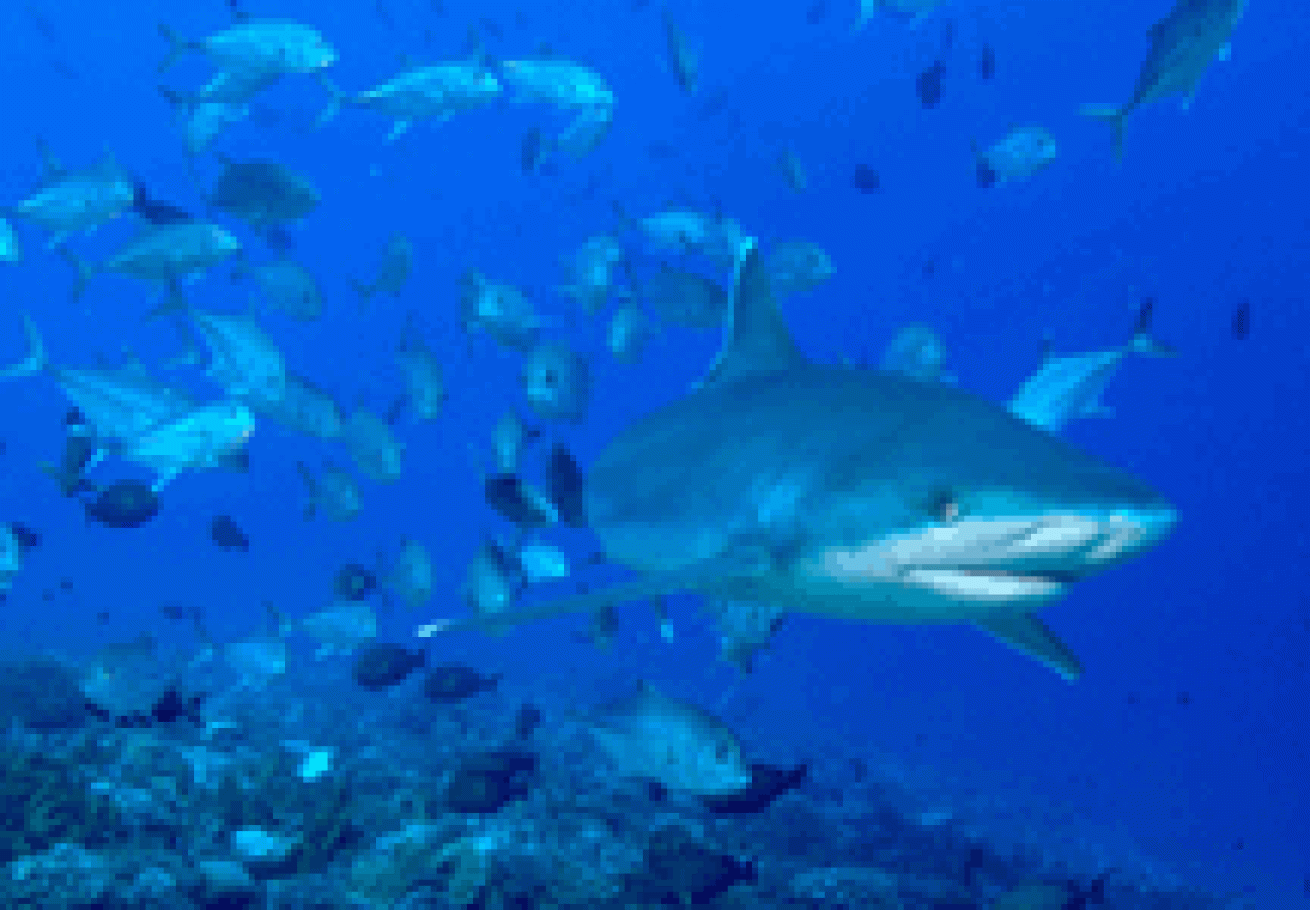Tahiti Aggressor - April 12-19, 2003
Text and Photography by Stephen Frink
Dive Log
||
|---|
|

|
| Photo of Stephen Frink taken by Mike Veitch, the Tahiti Aggressor's onboard photo pro.|
Inspired by Tahiti's tropical setting, Henri Matisse once asked, "Are you one of the seven wonders of an artist's heaven?" Matisse's body of work painted in vibrant colors answered the question in the affirmative. My question was skewed to my own special interest: "Tahiti, can you deliver world-class topside and underwater photo opportunities?" To find my answer, we chartered the Tahiti Aggressor for a live-aboard adventure in Tahiti and Her Islands.
As most trips to Pacific destinations begin, this one began with a group rendezvous at LAX before boarding a Air Tahiti Nui flight to Papeete on the island of Tahiti. Accustomed to 15-hour flights to most of our exotic dive destinations, we had barely immersed ourselves in our normal in-flight tedium when the plane landed just 7 hours later. Ahhhhhh . . . much closer than you'd think. Score one for Tahiti.
The Tahiti Aggressor has put together a very convenient "Welcome Package" that includes airport transfers and hotel accommodations--certainly a hassle-free option in an unfamiliar destination. We were met at the airport; luggage schlepped, and bussed away to the local Sheraton for a welcome night's sleep. Then off to Rangiroa to meet the boat.
The Tahiti to Rangiroa portion of the trip is possibly the biggest problem for a group of underwater photographers, only because of the baggage weight restrictions imposed for the domestic leg. No bag over 70 pounds is allowed. Fair enough, because that is the international standard as well, but only 50 pounds per person total baggage allowance without additional charge. And to even get the 50-pound allowance you may have to show a diver's C-card and international ticket. Excess baggage is $1.00 per pound, and only 1 carry-on per person (3 kilos recommended maximum for carry-on) is allowed. So, either travel light or budget for overweight charges.

Once on Rangiroa, we still had a few hours to kill while the crew made final preparations for our arrival. We had breakfast at a small rustic beachfront resort where our group's children (three girls, ages 10, 10, and 12; and a boy age 16) began their eternal snorkel quest for the best shells (no live critters allowed, of course). We then moved on to a considerably more upscale resort for lunch and a bit of beachcombing. By 2:00 p.m., we were welcomed aboard the boat to begin our week's adventure.
April 13
Fast forward past the boat briefing, safety drills, and the 120-mile first night's steam, to our checkout dive--a very mundane 40-foot reef called rather inappropriately "The Aquarium." Despite marginal visibility this day, I get one very nice diver silhouette set-up with boulder corals and clouds of blue anthias. But this dive is really only about working out weights and quickly moving on to the "good stuff."
The good stuff in Tahiti has much to do with currents, and often very high velocity currents. As we learned from our briefing, lunar cycles have a great deal to do with currents as well, and as full moon would happen during our cruise, we were told to expect significant current on some of the pass dives. Gratefully, the briefing also offered good suggestions about how to deal with such currents. Mother Ocean rules of course, but we will adapt as best we can.

The diving is really about two different environments. "Corners," where there is a gentle sloping wall, decorated in pristine hard corals and very little current. And "Passes," which is really different than you might have done anywhere else, and truly defines the best of Tahiti. Maybe there are some channel dives like these in the Maldives, and no doubt you'll find current like this in Cocos on some sites. But still these dives are unique, if only for the sheer quantity of sharks and the skills employed to get close to them. Any time the boat requires their divers to carry safety sausages, Dive Alerts, signal mirrors, and reef hooks, it is a fair bet there is likely to be some stiff current predicted along the way.
We discovered this on our first dive at N'Garuae Pass. The dive is launched from a sturdy 35-foot twin outboard aluminum skiff, needed to pick you up when you blow through the pass. The twin-outboard tender is complete with tank racks for 18 pax + crew, and ample deck space for multiple cameras. Once on location, we all quickly enter the water and quickly fin to the mouth of the channel at about 100 feet. These dives are timed to occur with the incoming tide for optimal visibility, safety (better to be blown into the lagoon than out to sea), and probable marine life encounters.
Here we use the reef hook to tie into a bit of coral rubble and wait for the action to come us. We had a gray reef sharks buzz us, but this first hook-in was only marginally productive. The sharks were hanging off in the distance, and even a bit of judicious bait cast to the flow did little to bring them near. So with our bottom time clock ticking, we cut loose and went flying.

I can never accurately gauge current, but when Captain Alan Roberts tells me we were drifting along in a medium velocity current of 5 knots, I have no reason not to believe him. Nor am I too eager to challenge the 8-knot currents they reputedly have at some of the sites where the passes are more narrow. I do know it was very hard to stop to take pictures, but when I could find a bit of lee to aim-camera-raise-strobe-arm, there were pockets along the reef that housed huge schools of crimson soldierfish and bigeyes as reward for the effort.
April 14April 15
Today's corner dives were along the outside face N'Garuae Pass, and as is typical of corner dives, reasonably immune to current. The bottom decoration was typified by pristine antler and boulder corals (no soft corals to be found here) as well as the ubiquitous gray reef sharks, Napoleon wrasse, unicornfish, and various reef tropicals. The photos were challenging because these were not in-your-face-fish. In fact, these fish don't see many divers and are justifiably aloof. Apparently both Passes and Corners will present their own unique photographic challenges.
We did two corner dives this day, Outhouse and Dreamland. Essentially they are the opposite sides of the pass, but the marine life was considerably different. Not surprisingly, this day the schooling barracuda and most of the sharks seemed to prefer hanging out in a Dreamland rather than an Outhouse.

On this day, we repeated the same dives, but caught the pass in a different mood and the sharks were much more interested in the bits of bait our shark wrangler Sebastian brought along. We had great fly-bys with the gray reefs, but I still wasn't getting the tight shark portraits I wanted. My mind's eye saw it all happening in a sweet spot about 10 yards ahead of where I was hooked in. It says something about the velocity of the current this day that it was just too hard to move cameras, unhook, and crawl hand-over-hand another 30 feet up the reef. I tuned my regulator to the hardest breathing position just to keep it from self-purging, and I had to struggle to keep the strobe aloft in the raging current. If this was a 5-knot current, 8 knots ought to be way interesting.
We did two pass dives this day, once again grateful for the 30% Nitrox mix onboard. After lunch we took the kids to a palm-studded beach lapped by turquoise waves. Classic Velvia tropical landscape, rich with greens, blues, and cyan, with a dash of white beach thrown in to enrich the palette.
Dreamland turned out to be a far more productive dive in the late afternoon. There was a school of sennet barracuda, but rather skittish actually. The snapper schools were more approachable, but the highlight of the dive was being swarmed by a massive school of bar jacks. They raced in out of the gloom, swirled all about, and then just as suddenly vanished into the murk of the outgoing tide.

While this might be income-tax deadline in the U.S., in the Tuamotus it was a "bite" of a different kind. Off the island of Toau we dived a corner known as Shark Bight and then did two dives at Otugi Pass. Jumping in the water on this first dive I was reminded how stunningly beautiful the color and clarity of the water is here in the Tuamotus. That, combined with the 84-degree water temperature, makes for a pretty magic immersion. Of course, it helps when the marine life cooperates, and this morning at Shark Bight, all was in synchronicity.
A friendly (and at times aggressive) small gray reef shark named "Scarface" made the early rounds, darting from photographer to photographer, democratically posing for all. Then my wife and I found a great little cleaning station with a pair of bannerfish and a solitary coral grouper waiting in queue line, seemingly oblivious to our presence. I knew from my camera's LCD we'd nailed that set-up, but there was one more willing poseur yet this dive, a large Napoleon wrasse that (for a change) allowed me to get close enough to shoot head shots with my 60mm macro lens.
Otugi Pass offered fairly gentle current on this first dive, yet the sharks were plenty frisky. Scarface led the charge for the bait, setting the tempo for the other sharks awaiting their turn. Almost from the moment we hit the water, we had shark action, although I turned away from it a couple of times to shoot the large schools of soldierfish. I'd like to have caught the big school of blue-lined snapper as well, but after a half-dozen sharks and an equal number of photographers burst through their symmetrical congregation, they pretty well scattered in disarray.
Most of the action centered on Sebastian again. No surprise since he had the bait. I got close to Seb to enhance my proximity to the sharks, but apparently Scarface felt I was a bit too near his personal stash of seafood. He rammed me really hard from behind, invisibly and very quickly, leaving me with a large bruise on my left bicep. Obviously it was a quasi-benign means of getting my attention, for it was just the blunt snout and not teeth. It did, however, remind me how fast, efficient, and downright sneaky a shark can be when motivated.

As the incoming tide picked up, we cruised effortlessly to one final set-up, several huge schools of bigeye along a submarine ledge. The hot shot was the sharks buzzing through the school, and while I still see that one in memory, I never got it on film. Or on digital for that matter.
April 16
By the time we burned enough surface interval to go back to Otugi Pass, the tide was beginning to go out, pulling dirty water from the lagoon. Still, the corner at least was clear enough for diving and we dropped in for a bit more shark action. We then cruised along the outside face of the wall where the clarity dramatically improved. A few of the sharks stayed with us, making for nice silhouettes of pristine hard coral and shark against the late afternoon sunburst.
Most everyone tends to be enraptured by the Tuamotus under water, but it would be a shame to miss the terrestrial beauty while visiting. You'll see beaches and palm trees in the distance, but simply asking the crew for a shore excursion will present awesome photo opportunities. I found a great spot for above-and-below shots with palm tree backgrounds over clear water. Unfortunately, there isn't lush coral inside the lagoons, so while the "overs" are pretty amazing, the "unders" leave a bit to be desired.
While the rest of our group finished off their dive day with another corner dive, Captain Alan introduced our daughter Alexa and her friend Hanna to their first ocean scuba dives. With infinite patience, and experience born of teaching his own daughter to dive, Alan lets the girls explore a shallow reef and share the thrill of breathing underwater. While the dive tender may be occupied with the four-dive-a-day regime, the crew is always willing to launch a shore expedition aboard their spacious rigid hull inflatable. In fact, most reasonable deviations from ship's routine seem to be possible, simply by asking.

Overnight we steamed about 20 miles to Apataki Atoll, home of the famed Tehere Pass. As we cruised into the lagoon on the early morning light it was obvious this pass is more narrow than most, squeezing a huge volume of water through a slim constriction at tidal change, creating (judging by the whirlpools and whitecaps in the channel) VELOCITY. Here they claim 8- to 10-knot currents are possible at peak tides, but the advantage is plenty of SHARKS.
Of course there are corner dives here too, and our first morning dive was at The Fish Holes. We were well-briefed about where the schools of squirrelfish and snapper were to be found, but the blue-lined snapper they predicted were a little deeper than advertised. I dropped to about 115 feet for them, but then found most of the other critters in the 60- to 70-foot range. So far so good. Nice safe, easy dive. But then I saw a massive school of bannerfish a little deeper than I should have gone at the end of the dive. In fact by the time I wrapped my series of shots and paid attention to the incessant beeping of my computer, I saw I was at 127 feet and well into air-table deco. No real drama since I was diving the Tahiti Aggressor's 30% mixture of Nitrox. They mix at this percentage rather than the standard 32% to account for the probability that something (critters or currents) might drag you a little deeper than intended. Gently drifting in crystalline 84-degree water to offgass isn't hard, but still I wanted to save my bottom time for the channel dives, so in retrospect this dive was more bottom-time-challenged than I would prefer. So, instead of diving the second scheduled corner dive, parents and kids went off in search of another deserted beach. A few more snorkel shots, a few more over/unders and then back to the boat to prep for what is reputed to be the highlight of the Aggressor itinerary, Apataki.

Mother Ocean rules these waters, and she was still asserting her authority today. The current kept running out to sea, pulling the dirty water from the lagoon, degrading visibility and making diving the channel generally unsafe. Finally, by late afternoon the current had slacked enough for us to try a dive, but obviously this wasn't going to be the ultra-clear, ultra-swift, incoming tide coursing through the channel that defines the Apataki experience. Yes, there were plenty of sharks, but the 45-foot visibility made shooting tough. I found my most productive spot just up current of the bait. This gave me pretty close encounters, but only average images so far this day.
April 17
To our great regret, that was our only chance at the pass. The current actually picked up later in the afternoon, still running out to sea and still offering grim visibility. Odd to spend a whole day on a location waiting for an incoming tide and not have one at all. The prevailing theory onboard is that with a south swell running, combined with the full moon, more water is spilling into the lagoons from the south than can be displaced by the tides. The analogy is that the Tuamotus are like a massive swimming pool being filled by a huge garden hose at the south end, and we are at the north end seeing the pool continually empty through the skimmers. Whatever weird meteorological or planetary influence combined, we missed what are no doubt some awesome pass dives. Oh well, next time.
This day wrapped with a final corner dive at a site known as Anchor. Of course there is an old anchor there, but the highlights for me included schooling sennet barracuda, one near pass made by a beautiful four-foot blacktip, a pair of cooperative raccoon butterflyfish, and another few swim-bys from the resident school of bar jack (also known as "convict jack" due to their vertical stripes and to differentiate from the Caribbean cousins of the same name).
While the hard corals thrive along these corners, and the scenery is lovely, the photo-ops are sometimes few and far between as compared to other Pacific dive destinations. However, I figured I had enough clownfish shots in life from other places, and probably enough soft coral too. So this week I'm happy to trade up to some shark action. Still, anyone planning to visit the Tuamotus and Rangiroa ought to be prepared for the probability of lots of shark encounters and current, for that's what the best of this diving is all about.

This morning's first dive is off Rangiroa at a site called Silverado, named for the silvertip sharks in residence. A little bait brings a pair of large silvertips in quite close, quite quickly. These are docile and beautiful animals clearly willing to take the bait, but in no real hurry to do so. There were a few gray reefs around, and a couple of other silvertips cruising the periphery of the feed, but the two 12-footers appeared to be in charge.
This shark encounter was extremely well-choreographed and executed. In addition to the predictable "sharks swirling around the bait" activity, the crew told us they would try to lure the sharks farther down the reef to where a school hundreds of horse-eye jacks reside. Then, when the silvertips show up the horse-eyes would break formation and dive against the sharks, rubbing against their sandpaper hide to dislodge parasites. Damn if it didn't happen just like they said. Obviously this crew has spent some time in these waters refining their itinerary, and they are happy to share their revelations.

The second dive offered a bit of excitement in that we moved out into the deep blue off the face of the reef and chummed for silvertips again. Having no bottom as reference made the encounter feel much different, and while it was not the constant adrenaline rush of Silverado, it was productive. After about 15 minutes we swam off to Windmill Reef, another corner dive. The passes just aren't going to be available to us this week, so we make do with some pretty good shallow reef dives on Windmill. We did see a large school of eagle rays, lots of very approachable reef tropicals, and several turtles; so I guess by any standard these are pretty good dives. Maybe not so great this day, but nothing a manta or whale shark wouldn't have fixed.
April 18
Note: I have read posts on the D2D message board written after the first few cruises aboard Tahiti Aggressor, and there were some grumblings about the food, or the local knowledge of the dive sites, or whatever. But I have to say chef Dems does a wonderful job with the food preparation, and the dive staff presents what could be challenging diving in a very safe and professional manner. Whatever learning curve might have been required of operations here; this boat and crew are now definitely up to the task. With tomorrow being the last half day of diving, I'm still captivated by the underwater experience, and find the topside ambience comfortable and cordial. Compliments to the crew.

Despite our entreaties to the Tahitian god of current flow, the pass is still pushing out to sea and our dive options are few. Essentially, back to Windmill or Silverado again. Well, Silverado was an easy sell to this group, especially considering how great it was yesterday. So we loaded up Sherman (their affectionate name for their battle-scarred but highly utilitarian dive tender) and cruised for about 30 minutes back to Silverado.
The day dive boats on Rangiroa are all inflatable Zodiacs, so when we saw one of these boats sitting on the mooring at Silverado we knew it portended poorly for us. Not only had we fed the sharks yesterday, but another dive group was there before us today. After all, how much gluttony will a self-respecting silvertip endure? Judging by their relative indifference to us this day, satiation had occurred. While we did get a couple of close passes, and even those were better than most silvertip shark encounters elsewhere, it was definitely not a repeat of yesterday's high-voltage action. Yet, with a slower pace on the shark action, we had more time to work the school of horse-eye jacks and other small tropicals along the reef slope.

With a flight home scheduled at 10:00 a.m. tomorrow, we had only one more dive before offgass time. With the pass still conspiring against us, it has to be Windmill. No wall of sharks for me this trip apparently, but at least I figured I could get a few more turtle shots as these are very common along Windmill Reef. In fact, no sooner had I hit the water I found a hawksbill chewing on bits of coral rubble, with bannerfish and regal angelfish darting in to nab any edible detritus uncovered in the process. All was going well with this series of photos, but when the excited grunts and gestures from our dive guide pointed seaward, I knew something more significant than a turtle was coming.
Out of the distant there soon materialized the distinctive shape of a manta. We all froze and stopped breathing, but couldn't fool the manta into getting closer. And since he was motivated to be elsewhere, I was motivated to swim along trying to get close. I closed to maybe 10 yards, close enough to appreciate the majesty of the whole scene, but hardly close enough to capture a world-class image. After an aerobic sprint to the shallows (aerobic for me, but apparently effortless for the manta), I had an even more aerobic struggle back to the drop-off against the current. Incredibly, the turtle (or one that looked just like it) was still there munching on coral, allowing me to complete my manta-interruptus mission.

Fast-forward again past cleaning dive gear and packing, past a very mediocre and over-priced last night's meal at Rangiroa's Kai Oro Village Resort, past the luggage shuffle and flight back to Tahiti, and I now find myself relaxing poolside at the Sheraton Papeete. I reflect on our Tahiti Aggressor adventure. No, we didn't have the wall of sharks I pictured in my mind's eye. The currents did not cooperate enough to give up that one very unique and very "Tahiti" image. But I did have plenty of chances to get close to gray reef sharks, had an unexpectedly wonderful photo-op with some gorgeous silvertips, saw a lovely manta, and encountered plenty of cooperative reef tropicals. We saw beautiful islands and enjoyed a full week of slick, calm seas and 84-degree water. My wife and I got to see our daughter make her first ocean scuba dive, and I got to hang out with a group of friends who shared a similar passion for photography, sharks, and love of the ocean.
Location - "Tahiti" is an island, but the official name of the island chain is "French Polynesia" and is a territory of France. Situated in the Pacific Ocean, directly south of Hawaii, these islands are about midway between LA and Australia. The best-known islands are Tahiti, Moorea, and Bora Bora, but collectively there are over 100 islands grouped into 5 archipelagos: the Society Islands, Austral Islands, Gambier Islands, the Tuamotus, and the Marquesas.
Packing - only 50 pounds per person total baggage allowance is permitted on the domestic (Rangiroa) leg, and that is only with a C-card and international ticket. Excess baggage is $1.00 per pound, not to exceed 70 pounds. Over 70 pounds will not be allowed on the airplane! Only 1 carry-on per person @ 3 kilograms maximum. This weight restriction on carry-on does not appear to be rigidly enforced, but overall weight restrictions and overweight charges will likely apply.
Cruising tax - There is a $50 per person cruising and tourism tax that will be collected on board.
-
Nikonos V with 15mm and 20mm lenses. Don't discount the utility of a wide-angle point and shoot like a Nikonos V for these kinds of conditions! Even if your shooting arsenal includes more sophisticated toys, the ease and optical correction of the Nikonos 15mm is a handy tool to have here.
-
Nikonos RS with 20-35mm zoom, 28mm and/or 50mm. I don't expect much super-wide subject matter like we might shoot with a 13mm, but the opportunity may present itself, so if you have one it is worth bringing. Actually, the one RS lens I did not bring, and wished for more than once, was the 28mm.
-
Housed camera - Film or digital - 60mm, 17-35mm zoom, 14mm, and a 16mm and dome port, especially for over/unders.
Would I do it again? Yes. In fact the first e-mail I sent today from the hotel was to Aggressor Fleet to book another whole boat charter for 2005. After all, I still need that Wall-O-Sharks, and this is the place to get them.
Trip Preparation Details

Time - Same as Hawaii, 3 hours behind Pacific Standard Time.
Flight Time from West Coast U.S. - 7 hours, arriving/departing Faaa Airport, near downtown Papeete.
Documents - For U.S. citizens, valid U.S. passport.
Currency - French Pacific Franc (CFP) traded at about 110 per US dollar, pegged to the Euro. Credit cards and U.S. dollars are widely accepted, except for local businesses where the CFP is preferred.
Languages - French and Tahitian are the official languages, but English is widely spoken.
Electricity - 220 volts. 110-volt electricity is available onboard the Tahiti Aggressor, and some hotels offer 110 volts in addition to 220.
Tipping - The Air Tahiti Nui informational literature states that "You should not tip anyone during your stay in Tahiti, as it is contrary to the Tahitian custom of hospitality." However, like any live-aboard, the Tahiti Aggressor will happily depart from this custom. Live-aboards typically expect about 10% of the charter price as a gratuity. So, depending on the quality of service rendered, a gratuity of $200 to $250 is reasonable for the boat portion of the tour.
Travel Miscellany

Tahiti Aggressor - 106-foot motor yacht (catamaran) with 9 double staterooms for maximum 18 guests. Each cabin has queen bed with twin bed loft, private head/shower, individually controlled AC. Diesel-powered, cruises at 12 knots, and has 110-volt electricity. Sockets are standard US type. E-6 film processing available on-board @ $10 per roll unmounted. Soft drinks, local beer and wine complimentary. Spirits may be available but expensive due to duties imposed. If you want hard liquor it may be wise to bring it along.

Water temperature - 79 degrees in winter and 84 degrees in summer. I recommend reading the Captain's log on www.aggressor.com to confirm water temperature in the weeks preceding your charter.
Air temperature - High 70s at night/low 80s during the day.
Recompression Chamber - Papeete. Be sure to carry DAN insurance or equivalent!
Credit cards - Visa, MC, and traveler's checks. Personal checks, Am Ex, and Discover are not accepted.
Diving Details - Tanks are 80-cu.-ft. aluminum. A few 60-cu.-ft. tanks are available for those who prefer a smaller tank. Some dives from mother ship, most others from twin-outboard powered skiff. Most dives are drift dives. No night diving. Dive Alerts and safety sausage, reflective mirror, and strobe are assigned to each diver before the first dive, for their use during the week. Nitrox is available.
Visibility - 80 to 120 feet given optimal conditions. Outgoing tide can suck dirty water from the lagoons and degrade water clarity accordingly. Expect 50 feet at the height of an outgoing tide near the mouth of a lagoon.
Photographic - Given the weight restrictions imposed by the domestic airlines and the probability of high currents, I think it is prudent to pack for predominantly wide-angle subjects, including pelagic critters like sharks and mantas, as well as schools of fish. A 60mm in a housing also makes sense, for that is good for both tropical fish and tight shark portraits. But I doubt many shooters will be concentrating on 105mm macro or extension tube kinds of critters. Not that there aren't blennies and dartfish, but when a shark or mantas cruises overhead, you won't want to be poking around in the coral rubble.

Instead, a logical shooting arsenal might include the following:
Note there are no night dives. But the Aggressor Fleet literature makes reference to lagoon "muck dives," even though none of this happened during our trip.
Topside - SLR, film or digital, with wide and normal lenses. I doubt there will be much need for telephoto lenses, and this may be a good opportunity to save on some weight.
Film - Even though I shoot at least 50% digital these days, I still make a point of bringing more than enough film along. Figure diving 20 - 22 dives, and shooting something less than 2 rolls per dive. Maybe the shark dives will be more "image-intense" and will require multiple cameras, but in heavy current a single camera is usually enough to deal with. I figured maybe 25 rolls for underwater and an equal number for topside should be enough for my needs, making a fair estimate at 50 rolls film, plus my digital images.
Photo Gallery
Tahiti Aggressor, April 12 - 19, 2003
Photography by Stephen Frink
 |
 |
 |
 |
 |
 |
 |
 |
 |
 |
 |
 |
 |
 |
 |
 |
 |
 |
 |
 |
 |
Text and Photography by Stephen Frink
Dive Log

| | Photo of Stephen Frink taken by Mike Veitch, the Tahiti Aggressor's onboard photo pro.| Inspired by Tahiti's tropical setting, Henri Matisse once asked, "Are you one of the seven wonders of an artist's heaven?" Matisse's body of work painted in vibrant colors answered the question in the affirmative. My question was skewed to my own special interest: "Tahiti, can you deliver world-class topside and underwater photo opportunities?" To find my answer, we chartered the Tahiti Aggressor for a live-aboard adventure in Tahiti and Her Islands.
As most trips to Pacific destinations begin, this one began with a group rendezvous at LAX before boarding a Air Tahiti Nui flight to Papeete on the island of Tahiti. Accustomed to 15-hour flights to most of our exotic dive destinations, we had barely immersed ourselves in our normal in-flight tedium when the plane landed just 7 hours later. Ahhhhhh . . . much closer than you'd think. Score one for Tahiti.
The Tahiti Aggressor has put together a very convenient "Welcome Package" that includes airport transfers and hotel accommodations--certainly a hassle-free option in an unfamiliar destination. We were met at the airport; luggage schlepped, and bussed away to the local Sheraton for a welcome night's sleep. Then off to Rangiroa to meet the boat.
The Tahiti to Rangiroa portion of the trip is possibly the biggest problem for a group of underwater photographers, only because of the baggage weight restrictions imposed for the domestic leg. No bag over 70 pounds is allowed. Fair enough, because that is the international standard as well, but only 50 pounds per person total baggage allowance without additional charge. And to even get the 50-pound allowance you may have to show a diver's C-card and international ticket. Excess baggage is $1.00 per pound, and only 1 carry-on per person (3 kilos recommended maximum for carry-on) is allowed. So, either travel light or budget for overweight charges.

Once on Rangiroa, we still had a few hours to kill while the crew made final preparations for our arrival. We had breakfast at a small rustic beachfront resort where our group's children (three girls, ages 10, 10, and 12; and a boy age 16) began their eternal snorkel quest for the best shells (no live critters allowed, of course). We then moved on to a considerably more upscale resort for lunch and a bit of beachcombing. By 2:00 p.m., we were welcomed aboard the boat to begin our week's adventure.
April 13
Fast forward past the boat briefing, safety drills, and the 120-mile first night's steam, to our checkout dive--a very mundane 40-foot reef called rather inappropriately "The Aquarium." Despite marginal visibility this day, I get one very nice diver silhouette set-up with boulder corals and clouds of blue anthias. But this dive is really only about working out weights and quickly moving on to the "good stuff."
The good stuff in Tahiti has much to do with currents, and often very high velocity currents. As we learned from our briefing, lunar cycles have a great deal to do with currents as well, and as full moon would happen during our cruise, we were told to expect significant current on some of the pass dives. Gratefully, the briefing also offered good suggestions about how to deal with such currents. Mother Ocean rules of course, but we will adapt as best we can.

The diving is really about two different environments. "Corners," where there is a gentle sloping wall, decorated in pristine hard corals and very little current. And "Passes," which is really different than you might have done anywhere else, and truly defines the best of Tahiti. Maybe there are some channel dives like these in the Maldives, and no doubt you'll find current like this in Cocos on some sites. But still these dives are unique, if only for the sheer quantity of sharks and the skills employed to get close to them. Any time the boat requires their divers to carry safety sausages, Dive Alerts, signal mirrors, and reef hooks, it is a fair bet there is likely to be some stiff current predicted along the way.
We discovered this on our first dive at N'Garuae Pass. The dive is launched from a sturdy 35-foot twin outboard aluminum skiff, needed to pick you up when you blow through the pass. The twin-outboard tender is complete with tank racks for 18 pax + crew, and ample deck space for multiple cameras. Once on location, we all quickly enter the water and quickly fin to the mouth of the channel at about 100 feet. These dives are timed to occur with the incoming tide for optimal visibility, safety (better to be blown into the lagoon than out to sea), and probable marine life encounters.
Here we use the reef hook to tie into a bit of coral rubble and wait for the action to come us. We had a gray reef sharks buzz us, but this first hook-in was only marginally productive. The sharks were hanging off in the distance, and even a bit of judicious bait cast to the flow did little to bring them near. So with our bottom time clock ticking, we cut loose and went flying.

I can never accurately gauge current, but when Captain Alan Roberts tells me we were drifting along in a medium velocity current of 5 knots, I have no reason not to believe him. Nor am I too eager to challenge the 8-knot currents they reputedly have at some of the sites where the passes are more narrow. I do know it was very hard to stop to take pictures, but when I could find a bit of lee to aim-camera-raise-strobe-arm, there were pockets along the reef that housed huge schools of crimson soldierfish and bigeyes as reward for the effort.
Today's corner dives were along the outside face N'Garuae Pass, and as is typical of corner dives, reasonably immune to current. The bottom decoration was typified by pristine antler and boulder corals (no soft corals to be found here) as well as the ubiquitous gray reef sharks, Napoleon wrasse, unicornfish, and various reef tropicals. The photos were challenging because these were not in-your-face-fish. In fact, these fish don't see many divers and are justifiably aloof. Apparently both Passes and Corners will present their own unique photographic challenges.
We did two corner dives this day, Outhouse and Dreamland. Essentially they are the opposite sides of the pass, but the marine life was considerably different. Not surprisingly, this day the schooling barracuda and most of the sharks seemed to prefer hanging out in a Dreamland rather than an Outhouse.
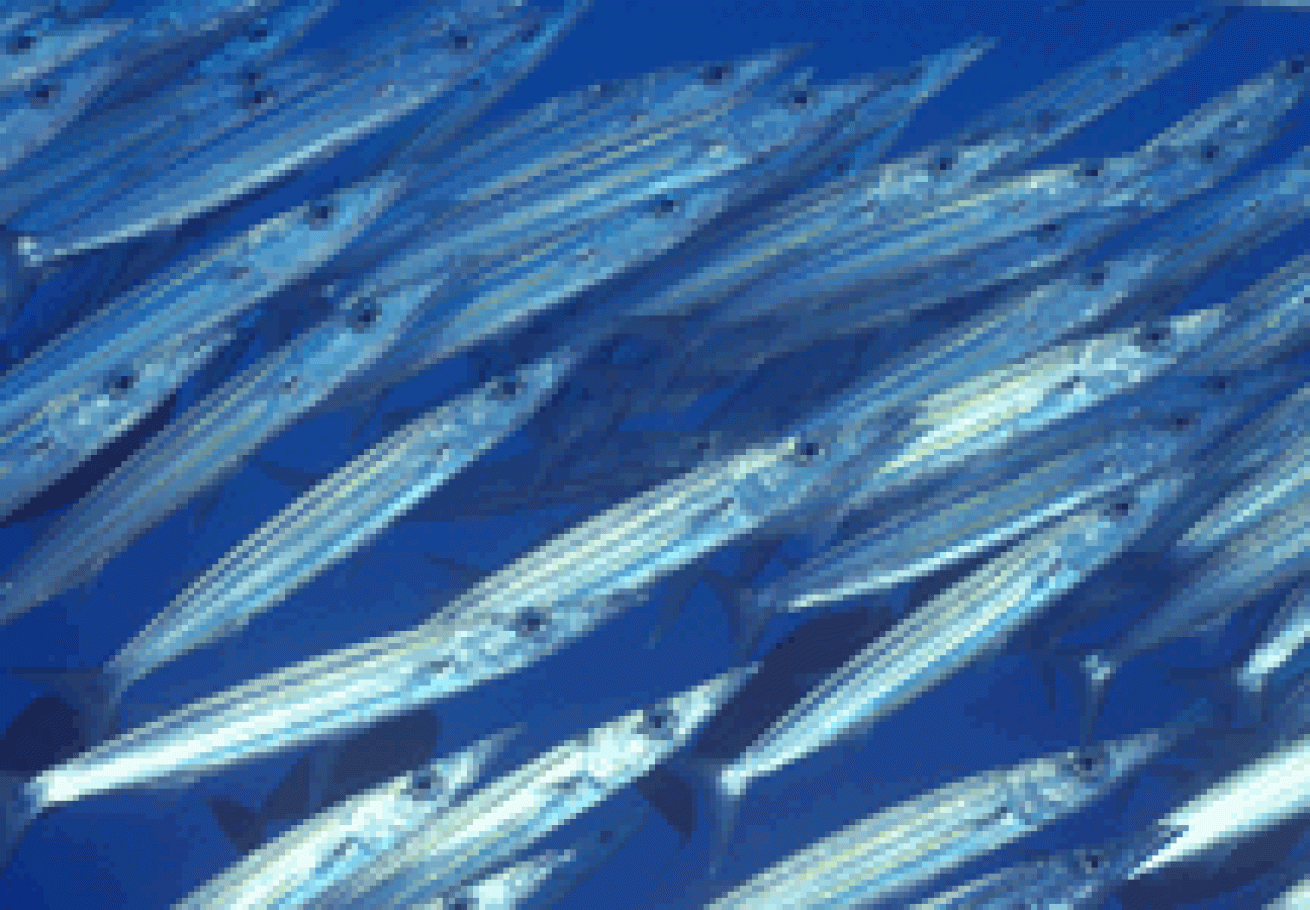
April 14
On this day, we repeated the same dives, but caught the pass in a different mood and the sharks were much more interested in the bits of bait our shark wrangler Sebastian brought along. We had great fly-bys with the gray reefs, but I still wasn't getting the tight shark portraits I wanted. My mind's eye saw it all happening in a sweet spot about 10 yards ahead of where I was hooked in. It says something about the velocity of the current this day that it was just too hard to move cameras, unhook, and crawl hand-over-hand another 30 feet up the reef. I tuned my regulator to the hardest breathing position just to keep it from self-purging, and I had to struggle to keep the strobe aloft in the raging current. If this was a 5-knot current, 8 knots ought to be way interesting.
We did two pass dives this day, once again grateful for the 30% Nitrox mix onboard. After lunch we took the kids to a palm-studded beach lapped by turquoise waves. Classic Velvia tropical landscape, rich with greens, blues, and cyan, with a dash of white beach thrown in to enrich the palette.
Dreamland turned out to be a far more productive dive in the late afternoon. There was a school of sennet barracuda, but rather skittish actually. The snapper schools were more approachable, but the highlight of the dive was being swarmed by a massive school of bar jacks. They raced in out of the gloom, swirled all about, and then just as suddenly vanished into the murk of the outgoing tide.
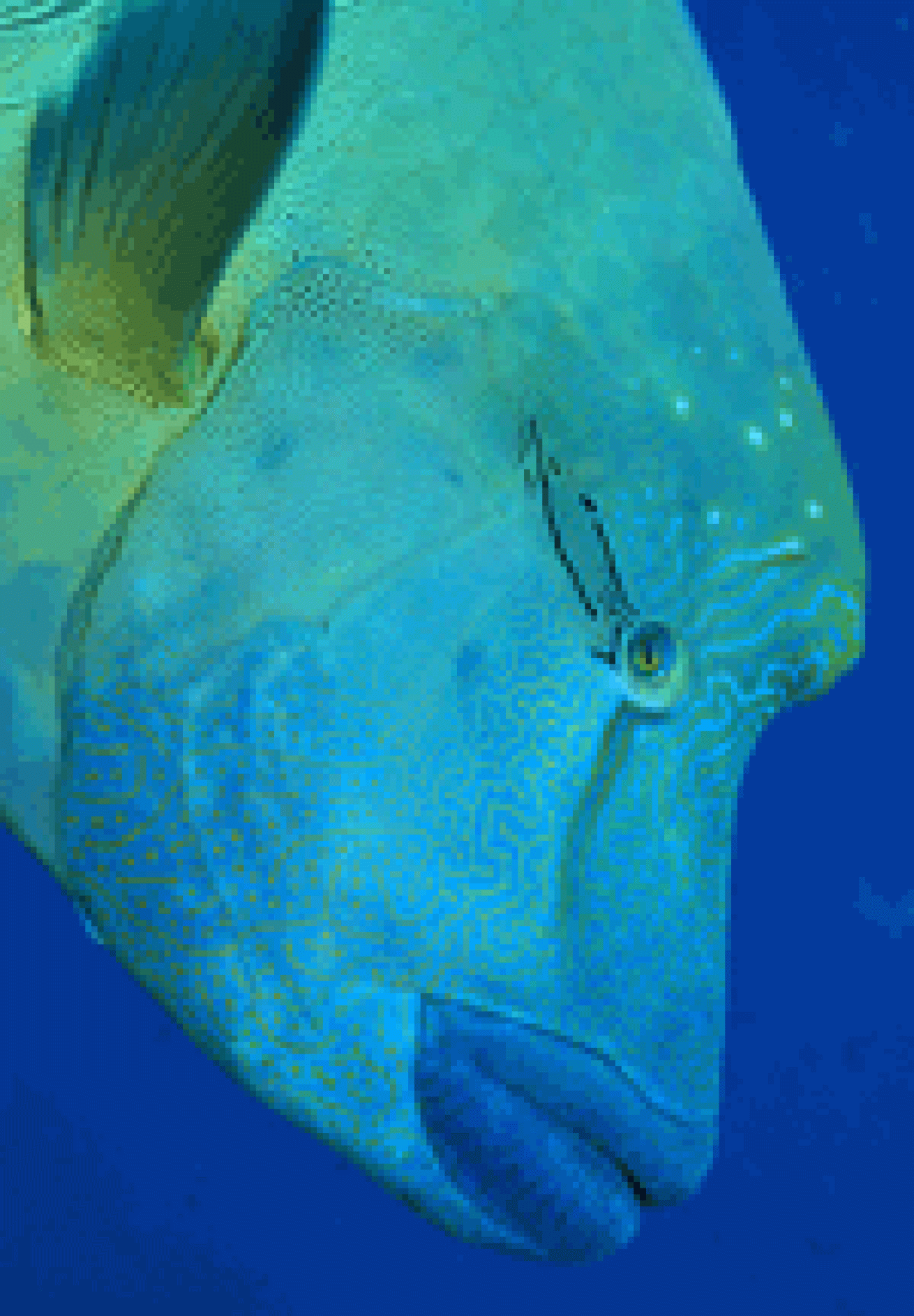
April 15
While this might be income-tax deadline in the U.S., in the Tuamotus it was a "bite" of a different kind. Off the island of Toau we dived a corner known as Shark Bight and then did two dives at Otugi Pass. Jumping in the water on this first dive I was reminded how stunningly beautiful the color and clarity of the water is here in the Tuamotus. That, combined with the 84-degree water temperature, makes for a pretty magic immersion. Of course, it helps when the marine life cooperates, and this morning at Shark Bight, all was in synchronicity.
A friendly (and at times aggressive) small gray reef shark named "Scarface" made the early rounds, darting from photographer to photographer, democratically posing for all. Then my wife and I found a great little cleaning station with a pair of bannerfish and a solitary coral grouper waiting in queue line, seemingly oblivious to our presence. I knew from my camera's LCD we'd nailed that set-up, but there was one more willing poseur yet this dive, a large Napoleon wrasse that (for a change) allowed me to get close enough to shoot head shots with my 60mm macro lens.
Otugi Pass offered fairly gentle current on this first dive, yet the sharks were plenty frisky. Scarface led the charge for the bait, setting the tempo for the other sharks awaiting their turn. Almost from the moment we hit the water, we had shark action, although I turned away from it a couple of times to shoot the large schools of soldierfish. I'd like to have caught the big school of blue-lined snapper as well, but after a half-dozen sharks and an equal number of photographers burst through their symmetrical congregation, they pretty well scattered in disarray.
Most of the action centered on Sebastian again. No surprise since he had the bait. I got close to Seb to enhance my proximity to the sharks, but apparently Scarface felt I was a bit too near his personal stash of seafood. He rammed me really hard from behind, invisibly and very quickly, leaving me with a large bruise on my left bicep. Obviously it was a quasi-benign means of getting my attention, for it was just the blunt snout and not teeth. It did, however, remind me how fast, efficient, and downright sneaky a shark can be when motivated.
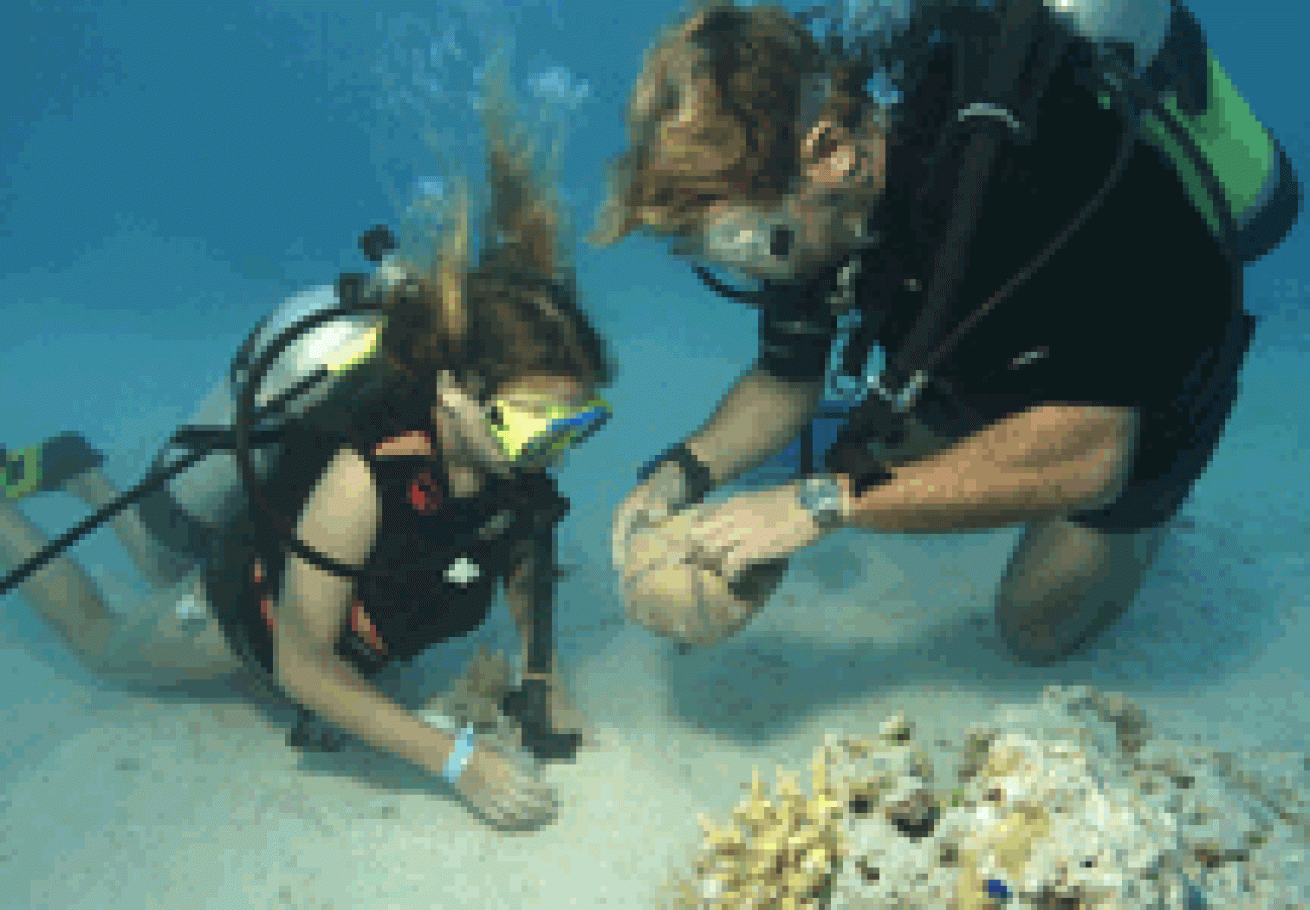
As the incoming tide picked up, we cruised effortlessly to one final set-up, several huge schools of bigeye along a submarine ledge. The hot shot was the sharks buzzing through the school, and while I still see that one in memory, I never got it on film. Or on digital for that matter.
By the time we burned enough surface interval to go back to Otugi Pass, the tide was beginning to go out, pulling dirty water from the lagoon. Still, the corner at least was clear enough for diving and we dropped in for a bit more shark action. We then cruised along the outside face of the wall where the clarity dramatically improved. A few of the sharks stayed with us, making for nice silhouettes of pristine hard coral and shark against the late afternoon sunburst.
Most everyone tends to be enraptured by the Tuamotus under water, but it would be a shame to miss the terrestrial beauty while visiting. You'll see beaches and palm trees in the distance, but simply asking the crew for a shore excursion will present awesome photo opportunities. I found a great spot for above-and-below shots with palm tree backgrounds over clear water. Unfortunately, there isn't lush coral inside the lagoons, so while the "overs" are pretty amazing, the "unders" leave a bit to be desired.
While the rest of our group finished off their dive day with another corner dive, Captain Alan introduced our daughter Alexa and her friend Hanna to their first ocean scuba dives. With infinite patience, and experience born of teaching his own daughter to dive, Alan lets the girls explore a shallow reef and share the thrill of breathing underwater. While the dive tender may be occupied with the four-dive-a-day regime, the crew is always willing to launch a shore expedition aboard their spacious rigid hull inflatable. In fact, most reasonable deviations from ship's routine seem to be possible, simply by asking.
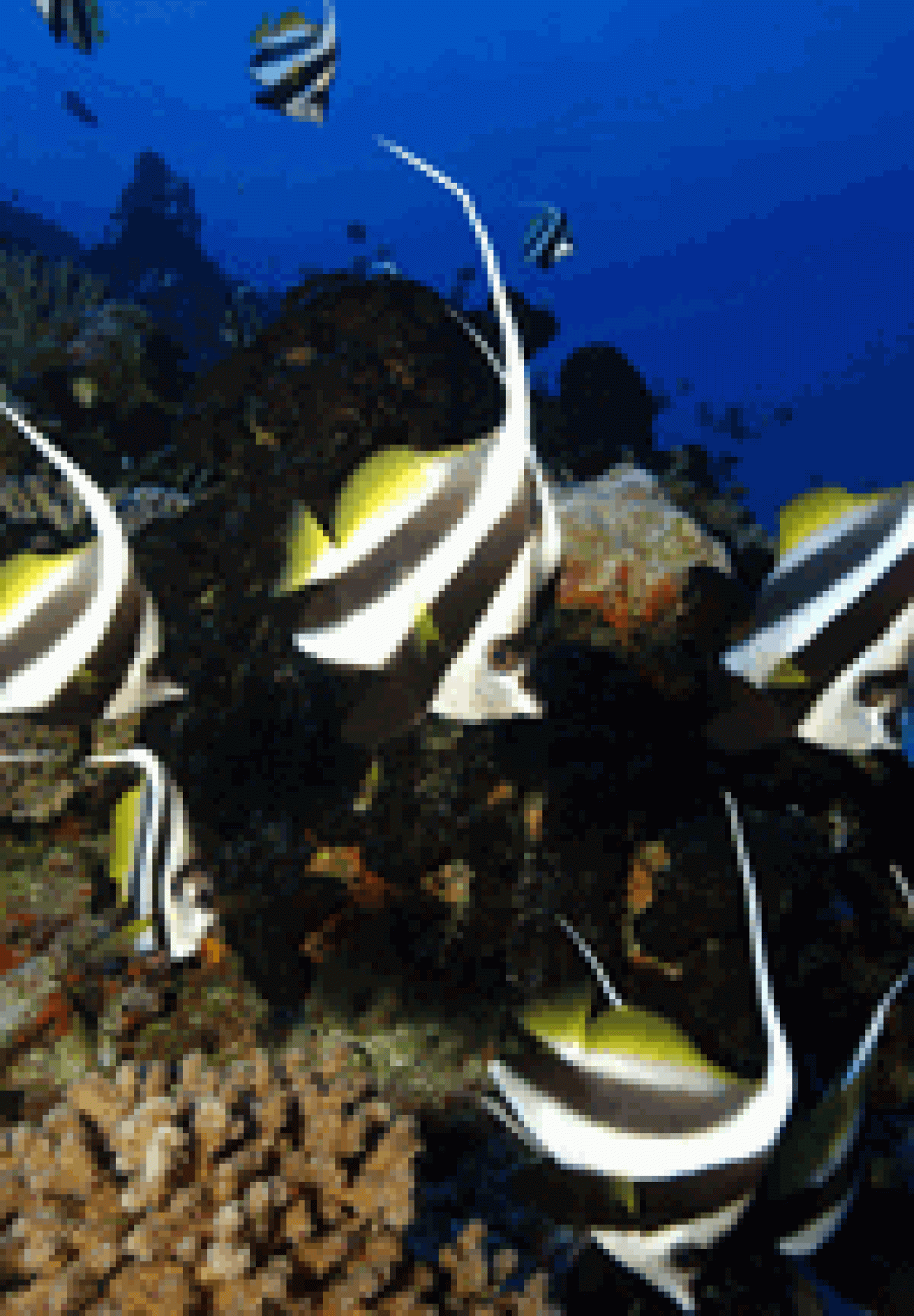
April 16
Overnight we steamed about 20 miles to Apataki Atoll, home of the famed Tehere Pass. As we cruised into the lagoon on the early morning light it was obvious this pass is more narrow than most, squeezing a huge volume of water through a slim constriction at tidal change, creating (judging by the whirlpools and whitecaps in the channel) VELOCITY. Here they claim 8- to 10-knot currents are possible at peak tides, but the advantage is plenty of SHARKS.
Of course there are corner dives here too, and our first morning dive was at The Fish Holes. We were well-briefed about where the schools of squirrelfish and snapper were to be found, but the blue-lined snapper they predicted were a little deeper than advertised. I dropped to about 115 feet for them, but then found most of the other critters in the 60- to 70-foot range. So far so good. Nice safe, easy dive. But then I saw a massive school of bannerfish a little deeper than I should have gone at the end of the dive. In fact by the time I wrapped my series of shots and paid attention to the incessant beeping of my computer, I saw I was at 127 feet and well into air-table deco. No real drama since I was diving the Tahiti Aggressor's 30% mixture of Nitrox. They mix at this percentage rather than the standard 32% to account for the probability that something (critters or currents) might drag you a little deeper than intended. Gently drifting in crystalline 84-degree water to offgass isn't hard, but still I wanted to save my bottom time for the channel dives, so in retrospect this dive was more bottom-time-challenged than I would prefer. So, instead of diving the second scheduled corner dive, parents and kids went off in search of another deserted beach. A few more snorkel shots, a few more over/unders and then back to the boat to prep for what is reputed to be the highlight of the Aggressor itinerary, Apataki.
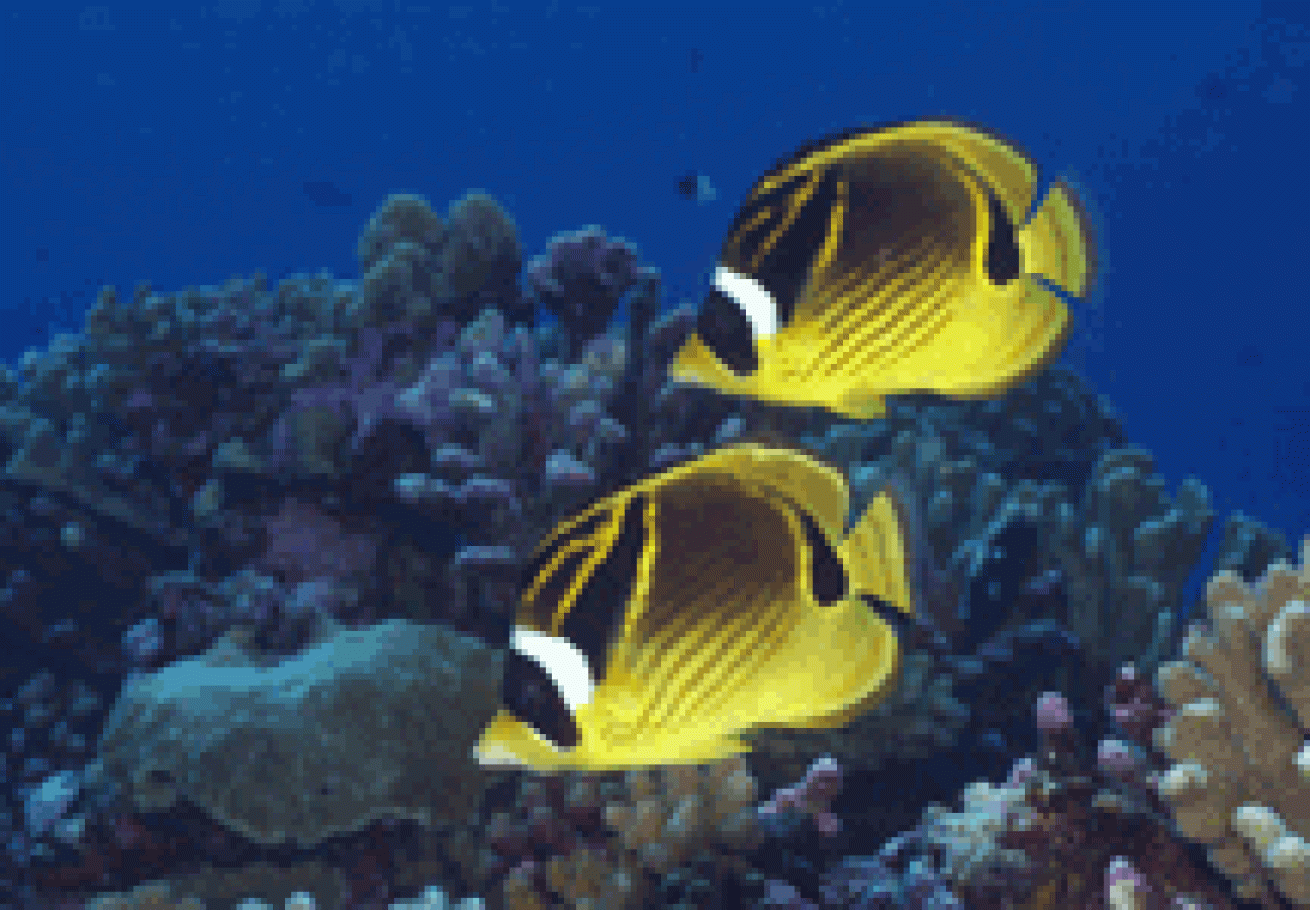
Mother Ocean rules these waters, and she was still asserting her authority today. The current kept running out to sea, pulling the dirty water from the lagoon, degrading visibility and making diving the channel generally unsafe. Finally, by late afternoon the current had slacked enough for us to try a dive, but obviously this wasn't going to be the ultra-clear, ultra-swift, incoming tide coursing through the channel that defines the Apataki experience. Yes, there were plenty of sharks, but the 45-foot visibility made shooting tough. I found my most productive spot just up current of the bait. This gave me pretty close encounters, but only average images so far this day.
To our great regret, that was our only chance at the pass. The current actually picked up later in the afternoon, still running out to sea and still offering grim visibility. Odd to spend a whole day on a location waiting for an incoming tide and not have one at all. The prevailing theory onboard is that with a south swell running, combined with the full moon, more water is spilling into the lagoons from the south than can be displaced by the tides. The analogy is that the Tuamotus are like a massive swimming pool being filled by a huge garden hose at the south end, and we are at the north end seeing the pool continually empty through the skimmers. Whatever weird meteorological or planetary influence combined, we missed what are no doubt some awesome pass dives. Oh well, next time.
This day wrapped with a final corner dive at a site known as Anchor. Of course there is an old anchor there, but the highlights for me included schooling sennet barracuda, one near pass made by a beautiful four-foot blacktip, a pair of cooperative raccoon butterflyfish, and another few swim-bys from the resident school of bar jack (also known as "convict jack" due to their vertical stripes and to differentiate from the Caribbean cousins of the same name).
While the hard corals thrive along these corners, and the scenery is lovely, the photo-ops are sometimes few and far between as compared to other Pacific dive destinations. However, I figured I had enough clownfish shots in life from other places, and probably enough soft coral too. So this week I'm happy to trade up to some shark action. Still, anyone planning to visit the Tuamotus and Rangiroa ought to be prepared for the probability of lots of shark encounters and current, for that's what the best of this diving is all about.

April 17
This morning's first dive is off Rangiroa at a site called Silverado, named for the silvertip sharks in residence. A little bait brings a pair of large silvertips in quite close, quite quickly. These are docile and beautiful animals clearly willing to take the bait, but in no real hurry to do so. There were a few gray reefs around, and a couple of other silvertips cruising the periphery of the feed, but the two 12-footers appeared to be in charge.
This shark encounter was extremely well-choreographed and executed. In addition to the predictable "sharks swirling around the bait" activity, the crew told us they would try to lure the sharks farther down the reef to where a school hundreds of horse-eye jacks reside. Then, when the silvertips show up the horse-eyes would break formation and dive against the sharks, rubbing against their sandpaper hide to dislodge parasites. Damn if it didn't happen just like they said. Obviously this crew has spent some time in these waters refining their itinerary, and they are happy to share their revelations.
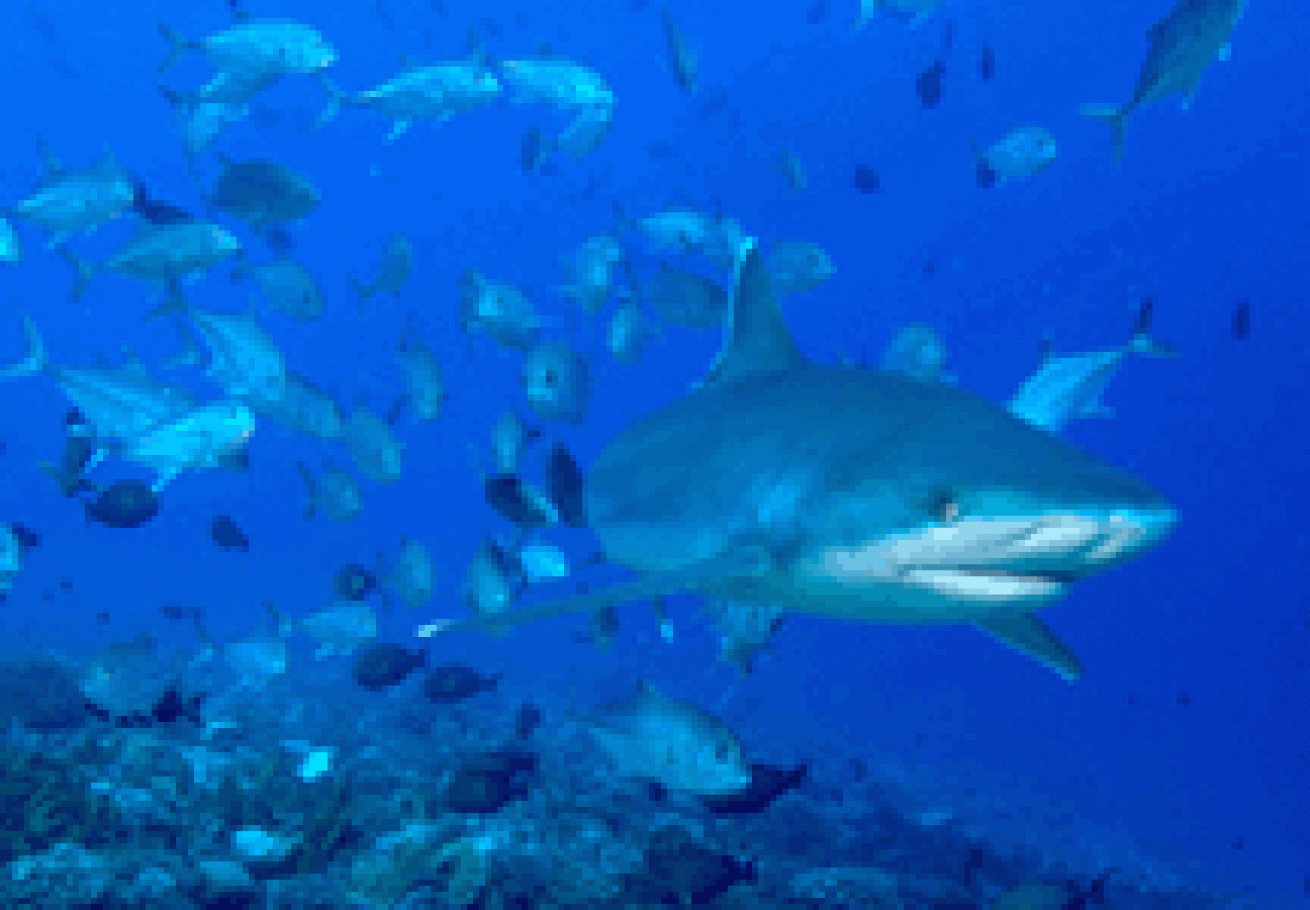
The second dive offered a bit of excitement in that we moved out into the deep blue off the face of the reef and chummed for silvertips again. Having no bottom as reference made the encounter feel much different, and while it was not the constant adrenaline rush of Silverado, it was productive. After about 15 minutes we swam off to Windmill Reef, another corner dive. The passes just aren't going to be available to us this week, so we make do with some pretty good shallow reef dives on Windmill. We did see a large school of eagle rays, lots of very approachable reef tropicals, and several turtles; so I guess by any standard these are pretty good dives. Maybe not so great this day, but nothing a manta or whale shark wouldn't have fixed.
Note: I have read posts on the D2D message board written after the first few cruises aboard Tahiti Aggressor, and there were some grumblings about the food, or the local knowledge of the dive sites, or whatever. But I have to say chef Dems does a wonderful job with the food preparation, and the dive staff presents what could be challenging diving in a very safe and professional manner. Whatever learning curve might have been required of operations here; this boat and crew are now definitely up to the task. With tomorrow being the last half day of diving, I'm still captivated by the underwater experience, and find the topside ambience comfortable and cordial. Compliments to the crew.
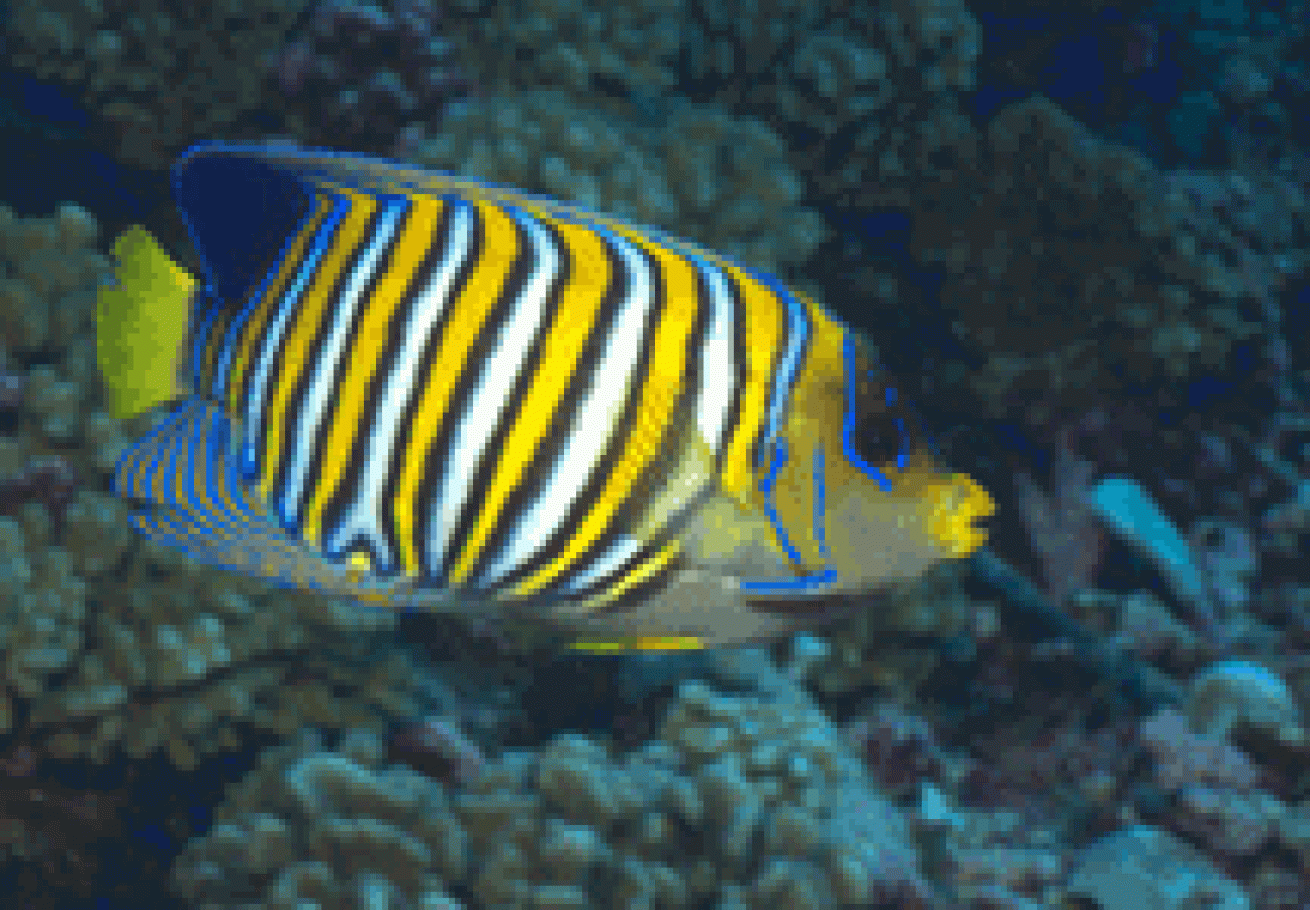
April 18
Despite our entreaties to the Tahitian god of current flow, the pass is still pushing out to sea and our dive options are few. Essentially, back to Windmill or Silverado again. Well, Silverado was an easy sell to this group, especially considering how great it was yesterday. So we loaded up Sherman (their affectionate name for their battle-scarred but highly utilitarian dive tender) and cruised for about 30 minutes back to Silverado.
The day dive boats on Rangiroa are all inflatable Zodiacs, so when we saw one of these boats sitting on the mooring at Silverado we knew it portended poorly for us. Not only had we fed the sharks yesterday, but another dive group was there before us today. After all, how much gluttony will a self-respecting silvertip endure? Judging by their relative indifference to us this day, satiation had occurred. While we did get a couple of close passes, and even those were better than most silvertip shark encounters elsewhere, it was definitely not a repeat of yesterday's high-voltage action. Yet, with a slower pace on the shark action, we had more time to work the school of horse-eye jacks and other small tropicals along the reef slope.
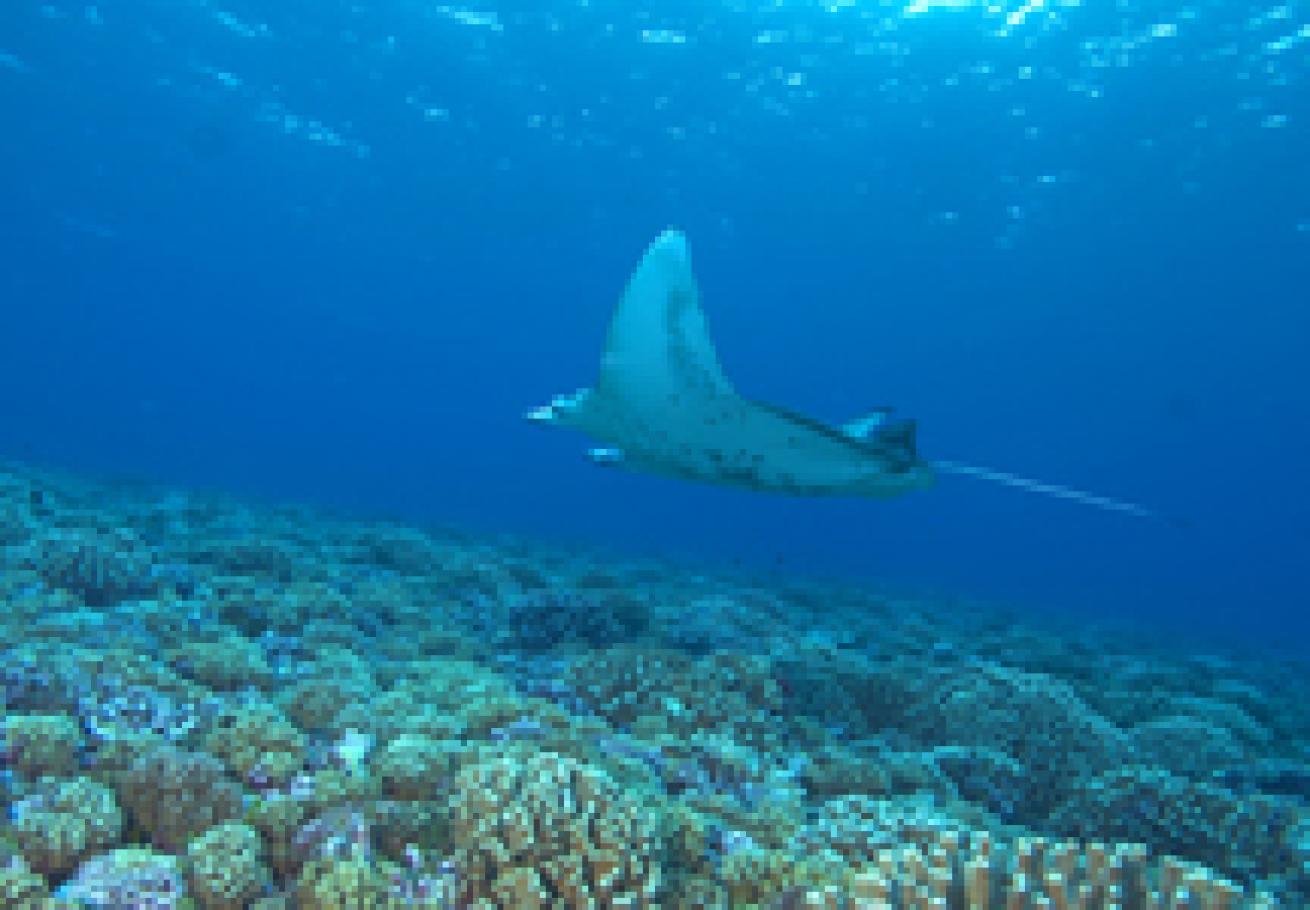
With a flight home scheduled at 10:00 a.m. tomorrow, we had only one more dive before offgass time. With the pass still conspiring against us, it has to be Windmill. No wall of sharks for me this trip apparently, but at least I figured I could get a few more turtle shots as these are very common along Windmill Reef. In fact, no sooner had I hit the water I found a hawksbill chewing on bits of coral rubble, with bannerfish and regal angelfish darting in to nab any edible detritus uncovered in the process. All was going well with this series of photos, but when the excited grunts and gestures from our dive guide pointed seaward, I knew something more significant than a turtle was coming.
Out of the distant there soon materialized the distinctive shape of a manta. We all froze and stopped breathing, but couldn't fool the manta into getting closer. And since he was motivated to be elsewhere, I was motivated to swim along trying to get close. I closed to maybe 10 yards, close enough to appreciate the majesty of the whole scene, but hardly close enough to capture a world-class image. After an aerobic sprint to the shallows (aerobic for me, but apparently effortless for the manta), I had an even more aerobic struggle back to the drop-off against the current. Incredibly, the turtle (or one that looked just like it) was still there munching on coral, allowing me to complete my manta-interruptus mission.
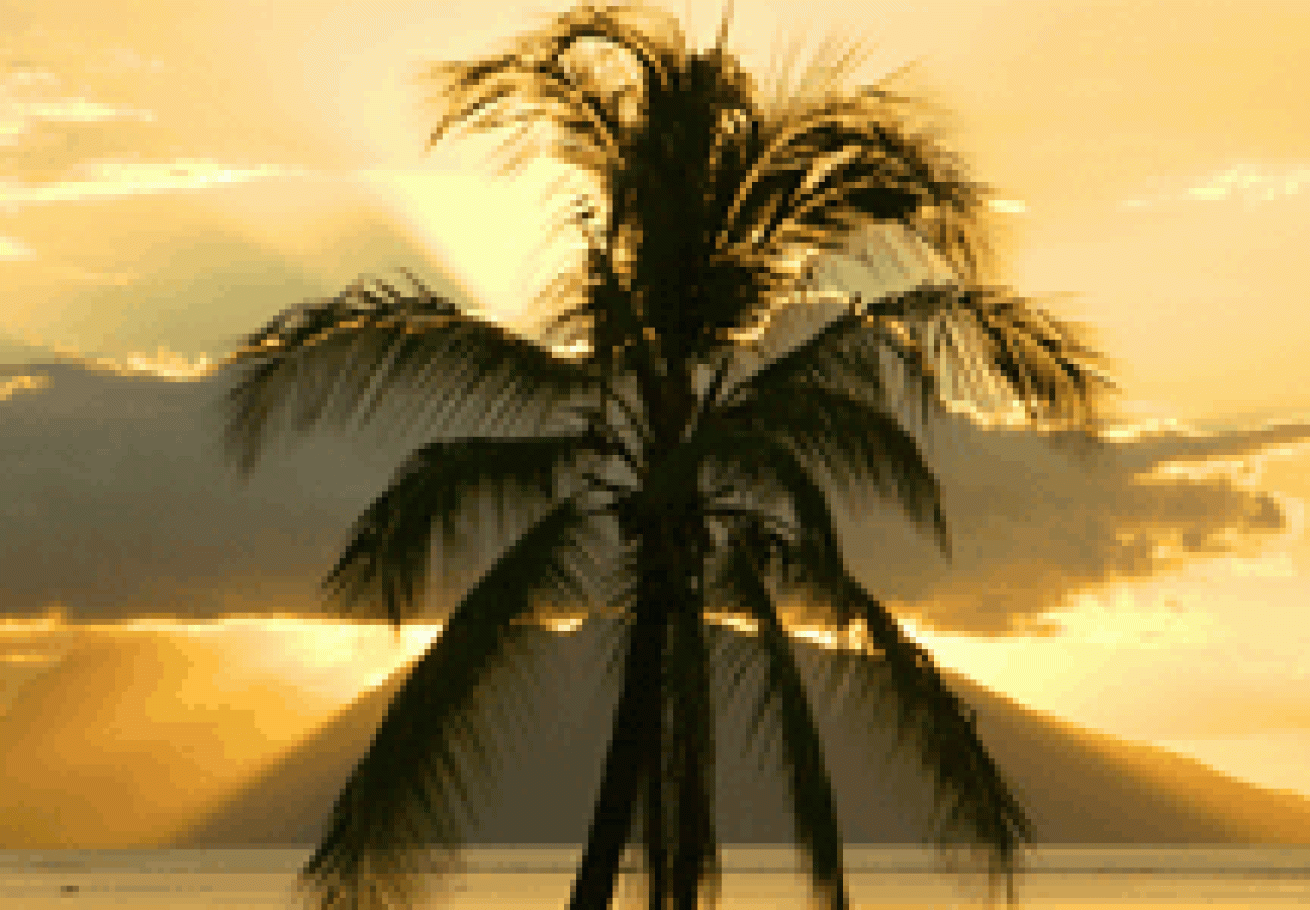
Fast-forward again past cleaning dive gear and packing, past a very mediocre and over-priced last night's meal at Rangiroa's Kai Oro Village Resort, past the luggage shuffle and flight back to Tahiti, and I now find myself relaxing poolside at the Sheraton Papeete. I reflect on our Tahiti Aggressor adventure. No, we didn't have the wall of sharks I pictured in my mind's eye. The currents did not cooperate enough to give up that one very unique and very "Tahiti" image. But I did have plenty of chances to get close to gray reef sharks, had an unexpectedly wonderful photo-op with some gorgeous silvertips, saw a lovely manta, and encountered plenty of cooperative reef tropicals. We saw beautiful islands and enjoyed a full week of slick, calm seas and 84-degree water. My wife and I got to see our daughter make her first ocean scuba dive, and I got to hang out with a group of friends who shared a similar passion for photography, sharks, and love of the ocean.
Would I do it again? Yes. In fact the first e-mail I sent today from the hotel was to Aggressor Fleet to book another whole boat charter for 2005. After all, I still need that Wall-O-Sharks, and this is the place to get them.
Trip Preparation Details

Location - "Tahiti" is an island, but the official name of the island chain is "French Polynesia" and is a territory of France. Situated in the Pacific Ocean, directly south of Hawaii, these islands are about midway between LA and Australia. The best-known islands are Tahiti, Moorea, and Bora Bora, but collectively there are over 100 islands grouped into 5 archipelagos: the Society Islands, Austral Islands, Gambier Islands, the Tuamotus, and the Marquesas.
Time - Same as Hawaii, 3 hours behind Pacific Standard Time.
Flight Time from West Coast U.S. - 7 hours, arriving/departing Faaa Airport, near downtown Papeete.
Documents - For U.S. citizens, valid U.S. passport.
Currency - French Pacific Franc (CFP) traded at about 110 per US dollar, pegged to the Euro. Credit cards and U.S. dollars are widely accepted, except for local businesses where the CFP is preferred.
Languages - French and Tahitian are the official languages, but English is widely spoken.
Electricity - 220 volts. 110-volt electricity is available onboard the Tahiti Aggressor, and some hotels offer 110 volts in addition to 220.
Tipping - The Air Tahiti Nui informational literature states that "You should not tip anyone during your stay in Tahiti, as it is contrary to the Tahitian custom of hospitality." However, like any live-aboard, the Tahiti Aggressor will happily depart from this custom. Live-aboards typically expect about 10% of the charter price as a gratuity. So, depending on the quality of service rendered, a gratuity of $200 to $250 is reasonable for the boat portion of the tour.
Travel Miscellany

Packing - only 50 pounds per person total baggage allowance is permitted on the domestic (Rangiroa) leg, and that is only with a C-card and international ticket. Excess baggage is $1.00 per pound, not to exceed 70 pounds. Over 70 pounds will not be allowed on the airplane! Only 1 carry-on per person @ 3 kilograms maximum. This weight restriction on carry-on does not appear to be rigidly enforced, but overall weight restrictions and overweight charges will likely apply.
Tahiti Aggressor - 106-foot motor yacht (catamaran) with 9 double staterooms for maximum 18 guests. Each cabin has queen bed with twin bed loft, private head/shower, individually controlled AC. Diesel-powered, cruises at 12 knots, and has 110-volt electricity. Sockets are standard US type. E-6 film processing available on-board @ $10 per roll unmounted. Soft drinks, local beer and wine complimentary. Spirits may be available but expensive due to duties imposed. If you want hard liquor it may be wise to bring it along.
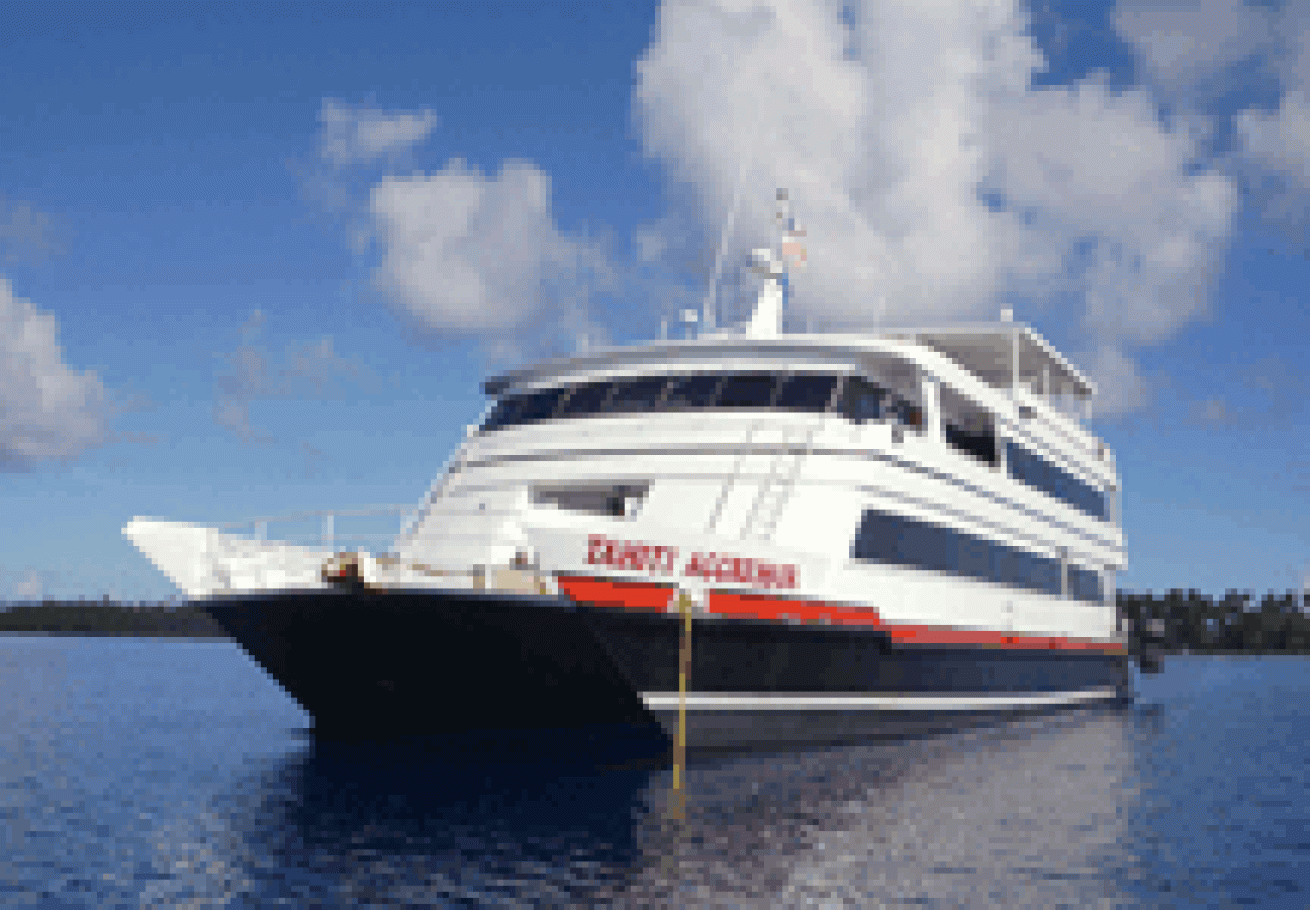
Cruising tax - There is a $50 per person cruising and tourism tax that will be collected on board.
Water temperature - 79 degrees in winter and 84 degrees in summer. I recommend reading the Captain's log on www.aggressor.com to confirm water temperature in the weeks preceding your charter.
Air temperature - High 70s at night/low 80s during the day.
Recompression Chamber - Papeete. Be sure to carry DAN insurance or equivalent!
Credit cards - Visa, MC, and traveler's checks. Personal checks, Am Ex, and Discover are not accepted.
Diving Details - Tanks are 80-cu.-ft. aluminum. A few 60-cu.-ft. tanks are available for those who prefer a smaller tank. Some dives from mother ship, most others from twin-outboard powered skiff. Most dives are drift dives. No night diving. Dive Alerts and safety sausage, reflective mirror, and strobe are assigned to each diver before the first dive, for their use during the week. Nitrox is available.
Visibility - 80 to 120 feet given optimal conditions. Outgoing tide can suck dirty water from the lagoons and degrade water clarity accordingly. Expect 50 feet at the height of an outgoing tide near the mouth of a lagoon.
Photographic - Given the weight restrictions imposed by the domestic airlines and the probability of high currents, I think it is prudent to pack for predominantly wide-angle subjects, including pelagic critters like sharks and mantas, as well as schools of fish. A 60mm in a housing also makes sense, for that is good for both tropical fish and tight shark portraits. But I doubt many shooters will be concentrating on 105mm macro or extension tube kinds of critters. Not that there aren't blennies and dartfish, but when a shark or mantas cruises overhead, you won't want to be poking around in the coral rubble.
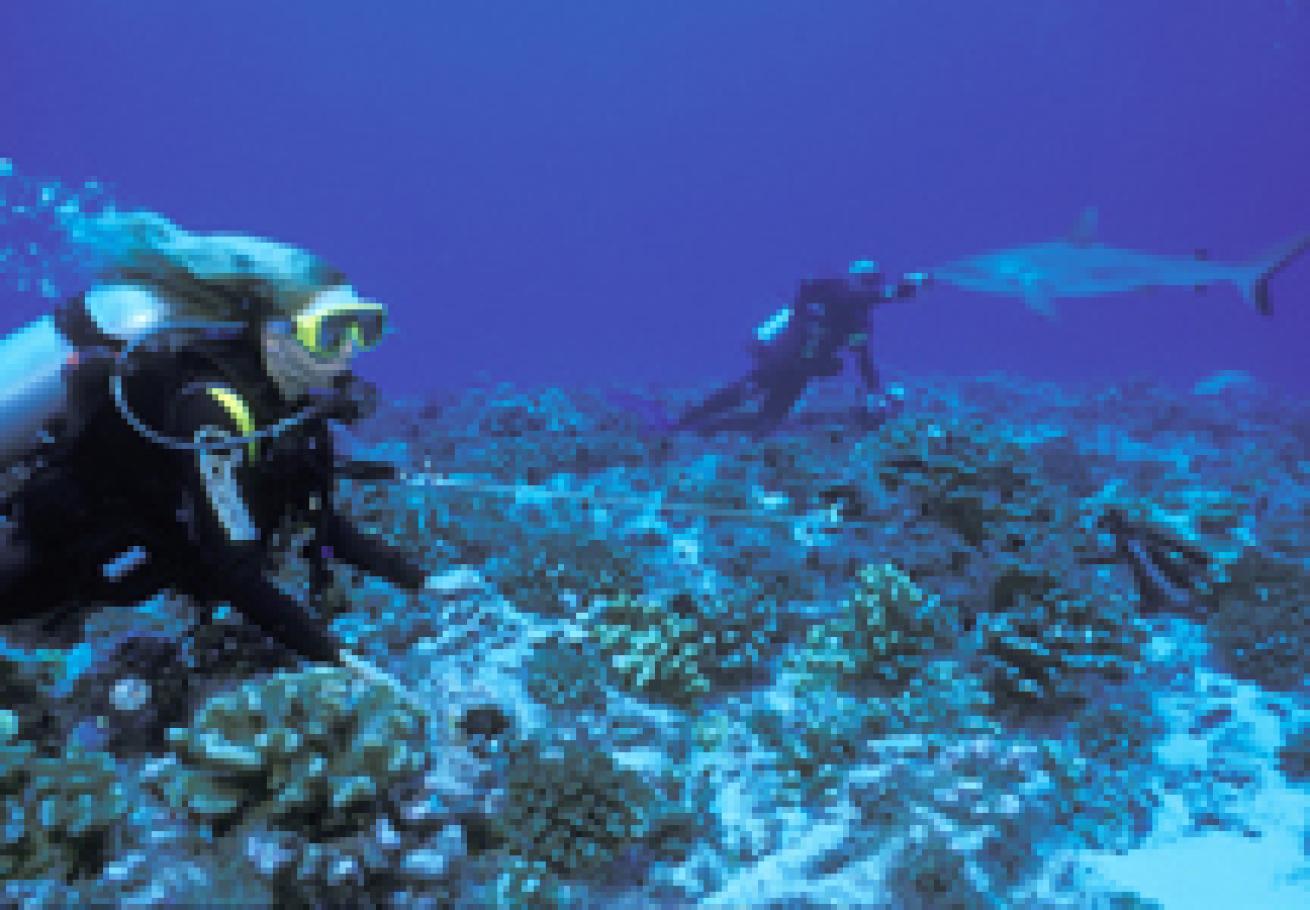
Instead, a logical shooting arsenal might include the following:
Nikonos V with 15mm and 20mm lenses. Don't discount the utility of a wide-angle point and shoot like a Nikonos V for these kinds of conditions! Even if your shooting arsenal includes more sophisticated toys, the ease and optical correction of the Nikonos 15mm is a handy tool to have here.
Nikonos RS with 20-35mm zoom, 28mm and/or 50mm. I don't expect much super-wide subject matter like we might shoot with a 13mm, but the opportunity may present itself, so if you have one it is worth bringing. Actually, the one RS lens I did not bring, and wished for more than once, was the 28mm.
Housed camera - Film or digital - 60mm, 17-35mm zoom, 14mm, and a 16mm and dome port, especially for over/unders.
Note there are no night dives. But the Aggressor Fleet literature makes reference to lagoon "muck dives," even though none of this happened during our trip.
Topside - SLR, film or digital, with wide and normal lenses. I doubt there will be much need for telephoto lenses, and this may be a good opportunity to save on some weight.
Film - Even though I shoot at least 50% digital these days, I still make a point of bringing more than enough film along. Figure diving 20 - 22 dives, and shooting something less than 2 rolls per dive. Maybe the shark dives will be more "image-intense" and will require multiple cameras, but in heavy current a single camera is usually enough to deal with. I figured maybe 25 rolls for underwater and an equal number for topside should be enough for my needs, making a fair estimate at 50 rolls film, plus my digital images.
Photo Gallery
Tahiti Aggressor, April 12 - 19, 2003
Photography by Stephen Frink
